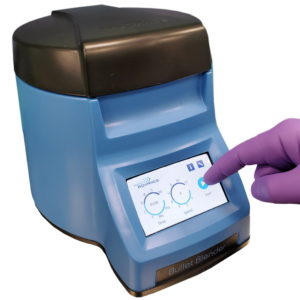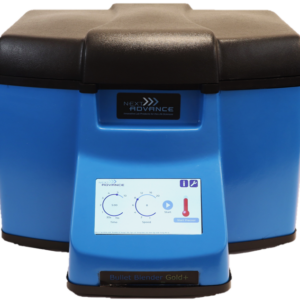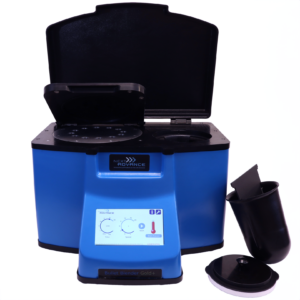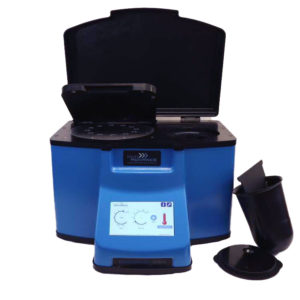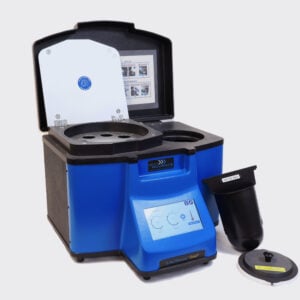Ideal for Placenta Tissue Homogenization
Do you spend lots of time and effort homogenizing placenta tissue samples? The Bullet Blender® tissue homogenizer delivers high quality and superior yields. No other homogenizer comes close to delivering the Bullet Blender’s winning combination of top-quality performance and budget-friendly affordability. See below for a placenta tissue homogenization protocol.
Save Time, Effort and Get Superior Results with
The Bullet Blender Homogenizer
Consistent and High Yield Results
Run up to 24 samples at the same time under microprocessor-controlled conditions, ensuring experimental reproducibility and high yield. Process samples from 10mg or less up to 3.5g.No Cross Contamination
No part of the Bullet Blender ever touches the tissue – the sample tubes are kept closed during homogenization. There are no probes to clean between samples.Samples Stay Cool
The Bullet Blenders’ innovative and elegant design provides convective cooling of the samples, so they do not heat up more than several degrees. In fact, our Gold+ models hold the sample temperature to about 4ºC.Easy and Convenient to Use
Just place beads and buffer along with your tissue sample in standard tubes, load tubes directly in the Bullet Blender, select time and speed, and press start.Risk Free Purchase
Thousands of peer-reviewed journal articles attest to the consistency and quality of the Bullet Blender homogenizer. We offer a 2 year warranty, extendable to 4 years, because our Bullet Blenders are reliable and last for many years.What Else Can You Homogenize? Tough or Soft, No Problem!
The Bullet Blender can process a wide range of samples including organ tissue, cell culture, plant tissue, and small organisms. You can homogenize samples as tough as mouse femur or for gentle applications such as tissue dissociation or organelle isolation.
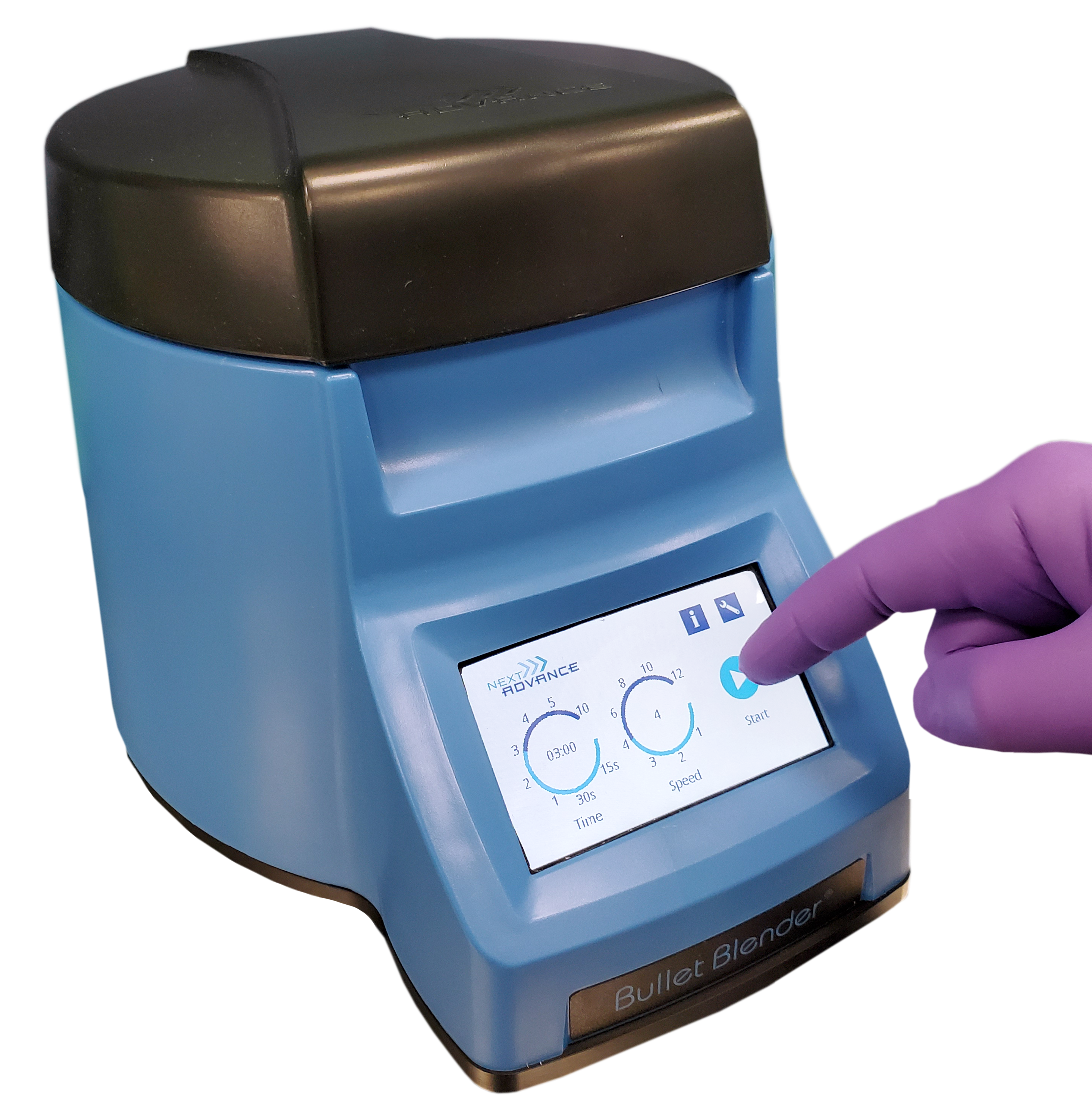
Want more guidance? Need a quote? Contact us:
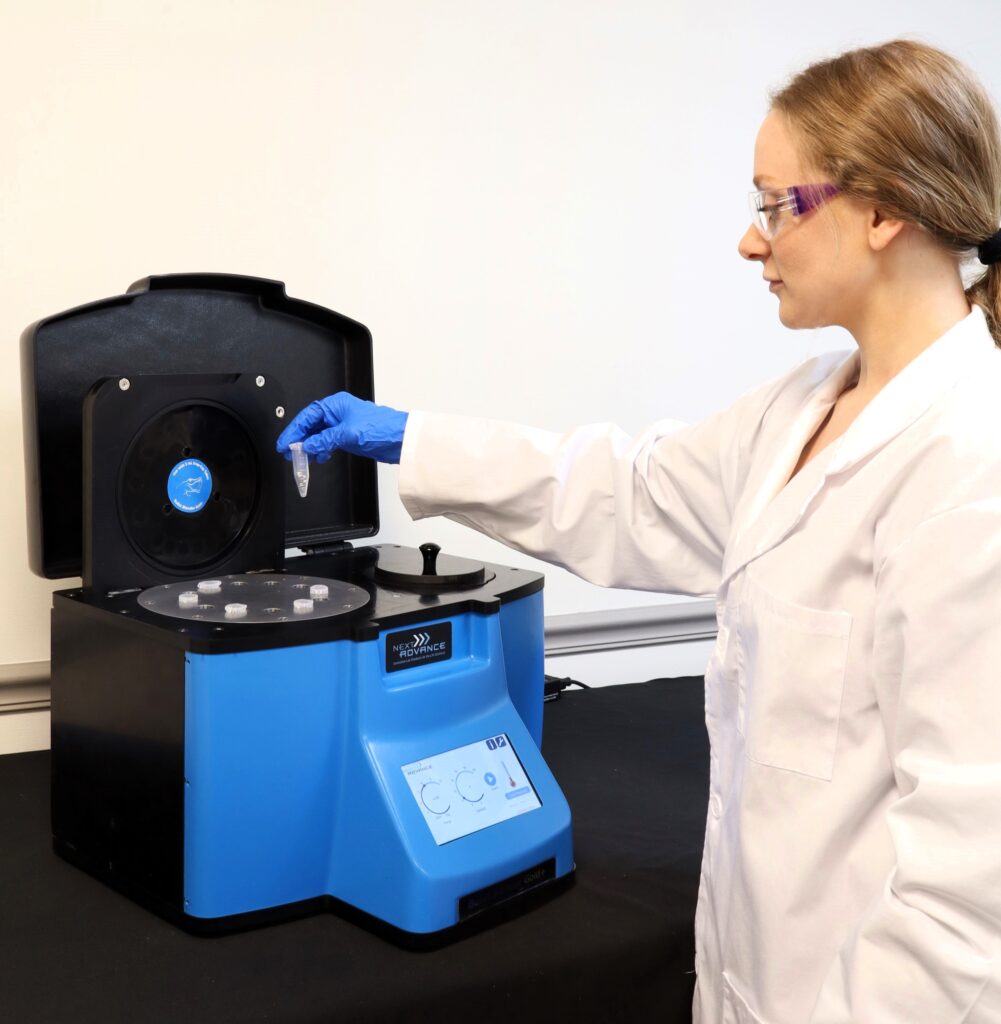
Bullet Blender Models
Select Publications using the Bullet Blender to Homogenize Placenta Tissue
2474232
placenta
1
apa
50
date
desc
10631
https://www.nextadvance.com/wp-content/plugins/zotpress/
%7B%22status%22%3A%22success%22%2C%22updateneeded%22%3Afalse%2C%22instance%22%3Afalse%2C%22meta%22%3A%7B%22request_last%22%3A0%2C%22request_next%22%3A0%2C%22used_cache%22%3Atrue%7D%2C%22data%22%3A%5B%7B%22key%22%3A%22X7SZ6KU4%22%2C%22library%22%3A%7B%22id%22%3A2474232%7D%2C%22meta%22%3A%7B%22creatorSummary%22%3A%22Rubinchik-Stern%20et%20al.%22%2C%22parsedDate%22%3A%222016-07%22%2C%22numChildren%22%3A2%7D%2C%22bib%22%3A%22%26lt%3Bdiv%20class%3D%26quot%3Bcsl-bib-body%26quot%3B%20style%3D%26quot%3Bline-height%3A%202%3B%20padding-left%3A%201em%3B%20text-indent%3A-1em%3B%26quot%3B%26gt%3B%5Cn%20%20%26lt%3Bdiv%20class%3D%26quot%3Bcsl-entry%26quot%3B%26gt%3BRubinchik-Stern%2C%20M.%2C%20Shmuel%2C%20M.%2C%20Bar%2C%20J.%2C%20Eyal%2C%20S.%2C%20%26amp%3B%20Kovo%2C%20M.%20%282016%29.%20Maternal%26%23x2013%3Bfetal%20transfer%20of%20indocyanine%20green%20across%20the%20perfused%20human%20placenta.%20%26lt%3Bi%26gt%3BReproductive%20Toxicology%26lt%3B%5C%2Fi%26gt%3B%2C%20%26lt%3Bi%26gt%3B62%26lt%3B%5C%2Fi%26gt%3B%2C%20100%26%23x2013%3B105.%20%26lt%3Ba%20class%3D%26%23039%3Bzp-DOIURL%26%23039%3B%20href%3D%26%23039%3Bhttps%3A%5C%2F%5C%2Fdoi.org%5C%2F10.1016%5C%2Fj.reprotox.2016.04.017%26%23039%3B%26gt%3Bhttps%3A%5C%2F%5C%2Fdoi.org%5C%2F10.1016%5C%2Fj.reprotox.2016.04.017%26lt%3B%5C%2Fa%26gt%3B%26lt%3B%5C%2Fdiv%26gt%3B%5Cn%26lt%3B%5C%2Fdiv%26gt%3B%22%2C%22data%22%3A%7B%22itemType%22%3A%22journalArticle%22%2C%22title%22%3A%22Maternal%5Cu2013fetal%20transfer%20of%20indocyanine%20green%20across%20the%20perfused%20human%20placenta%22%2C%22creators%22%3A%5B%7B%22creatorType%22%3A%22author%22%2C%22firstName%22%3A%22Miriam%22%2C%22lastName%22%3A%22Rubinchik-Stern%22%7D%2C%7B%22creatorType%22%3A%22author%22%2C%22firstName%22%3A%22Miriam%22%2C%22lastName%22%3A%22Shmuel%22%7D%2C%7B%22creatorType%22%3A%22author%22%2C%22firstName%22%3A%22Jacob%22%2C%22lastName%22%3A%22Bar%22%7D%2C%7B%22creatorType%22%3A%22author%22%2C%22firstName%22%3A%22Sara%22%2C%22lastName%22%3A%22Eyal%22%7D%2C%7B%22creatorType%22%3A%22author%22%2C%22firstName%22%3A%22Michal%22%2C%22lastName%22%3A%22Kovo%22%7D%5D%2C%22abstractNote%22%3A%22%5Cu496e%5Cu646f%5Cu6379%5Cu616e%5Cu696e%5Cu6520%5Cu6772%5Cu6565%5Cu6e20%5Cu2849%5Cu4347%5Cu2920%5Cu6973%5Cu2061%5Cu6e20%5Cu4644%5Cu412d%5Cu6170%5Cu7072%5Cu6f76%5Cu6564%5Cu206e%5Cu6561%5Cu722d%5Cu696e%5Cu6672%5Cu6172%5Cu6564%5Cu2069%5Cu6d61%5Cu6769%5Cu6e67%5Cu2070%5Cu726f%5Cu6265%5Cu2c20%5Cu6769%5Cu7665%5Cu6e20%5Cu616c%5Cu736f%5Cu2074%5Cu6f20%5Cu7072%5Cu6567%5Cu6e61%5Cu6e74%5Cu2077%5Cu6f6d%5Cu656e%5Cu2e20%5Cu5765%5Cu2061%5Cu696d%5Cu6564%5Cu2074%5Cu6f20%5Cu6368%5Cu6172%5Cu6163%5Cu7465%5Cu7269%5Cu7a65%5Cu2049%5Cu4347%5Cu2773%5Cu2074%5Cu7261%5Cu6e73%5Cu706c%5Cu6163%5Cu656e%5Cu7461%5Cu6c20%5Cu7472%5Cu616e%5Cu7366%5Cu6572%5Cu2075%5Cu7369%5Cu6e67%5Cu2074%5Cu6865%5Cu2065%5Cu782d%5Cu7669%5Cu766f%5Cu2070%5Cu6572%5Cu6675%5Cu7369%5Cu6f6e%5Cu206d%5Cu6f64%5Cu656c%5Cu2e20%5Cu506c%5Cu6163%5Cu656e%5Cu7461%5Cu7320%5Cu7765%5Cu7265%5Cu206f%5Cu6274%5Cu6169%5Cu6e65%5Cu6420%5Cu6672%5Cu6f6d%5Cu2063%5Cu6165%5Cu7361%5Cu7265%5Cu616e%5Cu2064%5Cu656c%5Cu6976%5Cu6572%5Cu6965%5Cu732e%5Cu2043%5Cu6f74%5Cu796c%5Cu6564%5Cu6f6e%5Cu7320%5Cu7765%5Cu7265%5Cu2063%5Cu616e%5Cu6e75%5Cu6c61%5Cu7465%5Cu6420%5Cu616e%5Cu6420%5Cu6475%5Cu616c%5Cu6c79%5Cu2070%5Cu6572%5Cu6675%5Cu7365%5Cu642e%5Cu2049%5Cu4347%5Cu2c20%5Cu392e%5Cu3620%5Cucebc%5Cu672f%5Cu6d4c%5Cu2061%5Cu6e64%5Cu2061%5Cu6e74%5Cu6970%5Cu7972%5Cu696e%5Cu6520%5Cu2835%5Cu3020%5Cucebc%5Cu672f%5Cu6d4c%5Cu2920%5Cu7765%5Cu7265%5Cu2061%5Cu6464%5Cu6564%5Cu2074%5Cu6f20%5Cu7468%5Cu6520%5Cu6d61%5Cu7465%5Cu726e%5Cu616c%5Cu2063%5Cu6972%5Cu6375%5Cu6c61%5Cu7469%5Cu6f6e%5Cu2069%5Cu6e20%5Cu7468%5Cu6520%5Cu6162%5Cu7365%5Cu6e63%5Cu6520%5Cu286e%5Cu203d%5Cu2034%5Cu2920%5Cu6f72%5Cu2074%5Cu6865%5Cu2070%5Cu7265%5Cu7365%5Cu6e63%5Cu6520%5Cu6f66%5Cu2074%5Cu6865%5Cu206f%5Cu7267%5Cu616e%5Cu6963%5Cu2061%5Cu6e69%5Cu6f6e%5Cu2074%5Cu7261%5Cu6e73%5Cu706f%5Cu7274%5Cu696e%5Cu6720%5Cu706f%5Cu6c79%5Cu7065%5Cu7074%5Cu6964%5Cu6520%5Cu284f%5Cu4154%5Cu5073%5Cu2920%5Cu696e%5Cu6869%5Cu6269%5Cu746f%5Cu7220%5Cu7269%5Cu6661%5Cu6d70%5Cu696e%5Cu2028%5Cu3130%5Cu20ce%5Cubc67%5Cu2f6d%5Cu4c3b%5Cu206e%5Cu203d%5Cu2035%5Cu2920%5Cu6f72%5Cu2074%5Cu6865%5Cu2050%5Cu2d67%5Cu6c79%5Cu636f%5Cu7072%5Cu6f74%5Cu6569%5Cu6e20%5Cu696e%5Cu6869%5Cu6269%5Cu746f%5Cu7220%5Cu7661%5Cu6c73%5Cu706f%5Cu6461%5Cu7220%5Cu2832%5Cu20ce%5Cubc67%5Cu2f6d%5Cu4c3b%5Cu206e%5Cu203d%5Cu2033%5Cu292e%5Cu2049%5Cu4347%5Cu2773%5Cu206d%5Cu6174%5Cu6572%5Cu6e61%5Cu6c2d%5Cu746f%5Cu2d66%5Cu6574%5Cu616c%5Cu2074%5Cu7261%5Cu6e73%5Cu6665%5Cu7220%5Cu7761%5Cu7320%5Cu6576%5Cu616c%5Cu7561%5Cu7465%5Cu6420%5Cu6f76%5Cu6572%5Cu2031%5Cu3830%5Cu206d%5Cu696e%5Cu2e20%5Cu5468%5Cu6520%5Cu6375%5Cu6d75%5Cu6c61%5Cu7469%5Cu7665%5Cu2070%5Cu6572%5Cu6365%5Cu6e74%5Cu206f%5Cu6620%5Cu4943%5Cu4720%5Cu696e%5Cu2074%5Cu6865%5Cu2066%5Cu6574%5Cu616c%5Cu2072%5Cu6573%5Cu6572%5Cu766f%5Cu6972%5Cu2077%5Cu6173%5Cu206d%5Cu696e%5Cu6f72%5Cu2e20%5Cu5768%5Cu656e%5Cu2049%5Cu4347%5Cu2074%5Cu7261%5Cu6e73%5Cu6665%5Cu7220%5Cu7761%5Cu7320%5Cu6e6f%5Cu726d%5Cu616c%5Cu697a%5Cu6564%5Cu2074%5Cu6f20%5Cu7468%5Cu6174%5Cu206f%5Cu6620%5Cu616e%5Cu7469%5Cu7079%5Cu7269%5Cu6e65%5Cu2c20%5Cu6974%5Cu2077%5Cu6173%5Cu206c%5Cu6f77%5Cu6572%5Cu2069%5Cu6e20%5Cu7468%5Cu6520%5Cu7072%5Cu6573%5Cu656e%5Cu6365%5Cu206f%5Cu6620%5Cu7269%5Cu6661%5Cu6d70%5Cu696e%5Cu2028%5Cu6120%5Cu3431%5Cu2520%5Cu6465%5Cu6372%5Cu6561%5Cu7365%5Cu3b20%5Cu7020%5Cu266c%5Cu743b%5Cu2030%5Cu2e30%5Cu3529%5Cu2e20%5Cu5661%5Cu6c73%5Cu706f%5Cu6461%5Cu7220%5Cu6469%5Cu6420%5Cu6e6f%5Cu7420%5Cu6170%5Cu7065%5Cu6172%5Cu2074%5Cu6f20%5Cu6d6f%5Cu6469%5Cu6679%5Cu2074%5Cu6865%5Cu206b%5Cu696e%5Cu6574%5Cu6963%5Cu7320%5Cu6f66%5Cu2049%5Cu4347%5Cu2e20%5Cu4943%5Cu4727%5Cu7320%5Cu7472%5Cu616e%5Cu7370%5Cu6c61%5Cu6365%5Cu6e74%5Cu616c%5Cu2074%5Cu7261%5Cu6e73%5Cu6665%5Cu7220%5Cu6973%5Cu206d%5Cu696e%5Cu696d%5Cu616c%5Cu2061%5Cu6e64%5Cu2069%5Cu7320%5Cu7072%5Cu6f62%5Cu6162%5Cu6c79%5Cu204f%5Cu4154%5Cu502d%5Cu6d65%5Cu6469%5Cu6174%5Cu6564%5Cu2e20%5Cu5468%5Cu6520%5Cu706c%5Cu6163%5Cu656e%5Cu7461%5Cu2069%5Cu7320%5Cu616e%5Cu2065%5Cu6666%5Cu6563%5Cu7469%5Cu7665%5Cu2070%5Cu726f%5Cu7465%5Cu6374%5Cu6976%5Cu6520%5Cu6261%5Cu7272%5Cu6965%5Cu7220%5Cu746f%5Cu2049%5Cu4347%5Cu2773%5Cu2064%5Cu6973%5Cu7472%5Cu6962%5Cu7574%5Cu696f%5Cu6e20%5Cu696e%5Cu746f%5Cu2074%5Cu6865%5Cu2066%5Cu6574%5Cu7573%3F%22%2C%22date%22%3A%22July%202016%22%2C%22language%22%3A%22%22%2C%22DOI%22%3A%2210.1016%5C%2Fj.reprotox.2016.04.017%22%2C%22ISSN%22%3A%220890-6238%22%2C%22url%22%3A%22http%3A%5C%2F%5C%2Fwww.sciencedirect.com%5C%2Fscience%5C%2Farticle%5C%2Fpii%5C%2FS0890623816300673%22%2C%22collections%22%3A%5B%22M2MNG549%22%5D%2C%22dateModified%22%3A%222016-06-10T18%3A24%3A14Z%22%7D%7D%2C%7B%22key%22%3A%22XDGMGHD3%22%2C%22library%22%3A%7B%22id%22%3A2474232%7D%2C%22meta%22%3A%7B%22creatorSummary%22%3A%22Bonney%20et%20al.%22%2C%22parsedDate%22%3A%222016-07%22%2C%22numChildren%22%3A2%7D%2C%22bib%22%3A%22%26lt%3Bdiv%20class%3D%26quot%3Bcsl-bib-body%26quot%3B%20style%3D%26quot%3Bline-height%3A%202%3B%20padding-left%3A%201em%3B%20text-indent%3A-1em%3B%26quot%3B%26gt%3B%5Cn%20%20%26lt%3Bdiv%20class%3D%26quot%3Bcsl-entry%26quot%3B%26gt%3BBonney%2C%20E.%20A.%2C%20Krebs%2C%20K.%2C%20Saade%2C%20G.%2C%20Kechichian%2C%20T.%2C%20Trivedi%2C%20J.%2C%20Huaizhi%2C%20Y.%2C%20%26amp%3B%20Menon%2C%20R.%20%282016%29.%20Differential%20senescence%20in%20feto-maternal%20tissues%20during%20mouse%20pregnancy.%20%26lt%3Bi%26gt%3BPlacenta%26lt%3B%5C%2Fi%26gt%3B%2C%20%26lt%3Bi%26gt%3B43%26lt%3B%5C%2Fi%26gt%3B%2C%2026%26%23x2013%3B34.%20%26lt%3Ba%20class%3D%26%23039%3Bzp-DOIURL%26%23039%3B%20href%3D%26%23039%3Bhttps%3A%5C%2F%5C%2Fdoi.org%5C%2F10.1016%5C%2Fj.placenta.2016.04.018%26%23039%3B%26gt%3Bhttps%3A%5C%2F%5C%2Fdoi.org%5C%2F10.1016%5C%2Fj.placenta.2016.04.018%26lt%3B%5C%2Fa%26gt%3B%26lt%3B%5C%2Fdiv%26gt%3B%5Cn%26lt%3B%5C%2Fdiv%26gt%3B%22%2C%22data%22%3A%7B%22itemType%22%3A%22journalArticle%22%2C%22title%22%3A%22Differential%20senescence%20in%20feto-maternal%20tissues%20during%20mouse%20pregnancy%22%2C%22creators%22%3A%5B%7B%22creatorType%22%3A%22author%22%2C%22firstName%22%3A%22Elizabeth%20A.%22%2C%22lastName%22%3A%22Bonney%22%7D%2C%7B%22creatorType%22%3A%22author%22%2C%22firstName%22%3A%22Kendall%22%2C%22lastName%22%3A%22Krebs%22%7D%2C%7B%22creatorType%22%3A%22author%22%2C%22firstName%22%3A%22George%22%2C%22lastName%22%3A%22Saade%22%7D%2C%7B%22creatorType%22%3A%22author%22%2C%22firstName%22%3A%22Talar%22%2C%22lastName%22%3A%22Kechichian%22%7D%2C%7B%22creatorType%22%3A%22author%22%2C%22firstName%22%3A%22Jayshil%22%2C%22lastName%22%3A%22Trivedi%22%7D%2C%7B%22creatorType%22%3A%22author%22%2C%22firstName%22%3A%22Yin%22%2C%22lastName%22%3A%22Huaizhi%22%7D%2C%7B%22creatorType%22%3A%22author%22%2C%22firstName%22%3A%22Ramkumar%22%2C%22lastName%22%3A%22Menon%22%7D%5D%2C%22abstractNote%22%3A%22%5Cu4261%5Cu636b%5Cu6772%5Cu6f75%5Cu6e64%5Cu0a48%5Cu756d%5Cu616e%5Cu2073%5Cu7475%5Cu6469%5Cu6573%5Cu2073%5Cu686f%5Cu7720%5Cu7468%5Cu6174%5Cu2066%5Cu6574%5Cu616c%5Cu206d%5Cu656d%5Cu6272%5Cu616e%5Cu6573%5Cu2068%5Cu6176%5Cu6520%5Cu6120%5Cu6c69%5Cu6d69%5Cu7465%5Cu6420%5Cu6c69%5Cu6665%5Cu7370%5Cu616e%5Cu2061%5Cu6e64%5Cu2075%5Cu6e64%5Cu6572%5Cu676f%5Cu2074%5Cu656c%5Cu6f6d%5Cu6572%5Cu652d%5Cu6465%5Cu7065%5Cu6e64%5Cu656e%5Cu7420%5Cu6365%5Cu6c6c%5Cu756c%5Cu6172%5Cu2073%5Cu656e%5Cu6573%5Cu6365%5Cu6e63%5Cu6520%5Cu7468%5Cu6174%5Cu2069%5Cu7320%5Cu6175%5Cu676d%5Cu656e%5Cu7465%5Cu6420%5Cu6279%5Cu206f%5Cu7869%5Cu6461%5Cu7469%5Cu7665%5Cu2073%5Cu7472%5Cu6573%5Cu7320%5Cu616e%5Cu6420%5Cu6d65%5Cu6469%5Cu6174%5Cu6564%5Cu2062%5Cu7920%5Cu7033%5Cu3820%5Cu6d69%5Cu746f%5Cu6765%5Cu6e20%5Cu6163%5Cu7469%5Cu7661%5Cu7465%5Cu6420%5Cu7072%5Cu6f74%5Cu6569%5Cu6e20%5Cu6b69%5Cu6e61%5Cu7365%5Cu2028%5Cu4d41%5Cu504b%5Cu292e%5Cu2046%5Cu7572%5Cu7468%5Cu6572%5Cu2c20%5Cu7468%5Cu6573%5Cu6520%5Cu7374%5Cu7564%5Cu6965%5Cu7320%5Cu7375%5Cu6767%5Cu6573%5Cu7420%5Cu7468%5Cu6174%5Cu2066%5Cu6574%5Cu616c%5Cu206d%5Cu656d%5Cu6272%5Cu616e%5Cu6573%5Cu2061%5Cu7265%5Cu2061%5Cu6e61%5Cu746f%5Cu6d69%5Cu6361%5Cu6c6c%5Cu7920%5Cu616e%5Cu6420%5Cu7068%5Cu7973%5Cu696f%5Cu6c6f%5Cu6769%5Cu6361%5Cu6c6c%5Cu7920%5Cu706f%5Cu7369%5Cu7469%5Cu6f6e%5Cu6564%5Cu2074%5Cu6f20%5Cu7472%5Cu616e%5Cu736d%5Cu6974%5Cu2073%5Cu656e%5Cu6573%5Cu6365%5Cu6e63%5Cu6520%5Cu7369%5Cu676e%5Cu616c%5Cu7320%5Cu7468%5Cu6174%5Cu206d%5Cu6179%5Cu2069%5Cu6e69%5Cu7469%5Cu6174%5Cu6520%5Cu7061%5Cu7274%5Cu7572%5Cu6974%5Cu696f%5Cu6e20%5Cu6174%5Cu2074%5Cu6572%5Cu6d2e%5Cu0a4d%5Cu6574%5Cu686f%5Cu6473%5Cu0a4c%5Cu6f6e%5Cu6769%5Cu7475%5Cu6469%5Cu6e61%5Cu6c20%5Cu6576%5Cu616c%5Cu7561%5Cu7469%5Cu6f6e%5Cu206f%5Cu6620%5Cu6665%5Cu746f%5Cu2d6d%5Cu6174%5Cu6572%5Cu6e61%5Cu6c20%5Cu7469%5Cu7373%5Cu7565%5Cu7320%5Cu6672%5Cu6f6d%5Cu206d%5Cu6f75%5Cu7365%5Cu2070%5Cu7265%5Cu676e%5Cu616e%5Cu6369%5Cu6573%5Cu2077%5Cu6173%5Cu2075%5Cu6e64%5Cu6572%5Cu7461%5Cu6b65%5Cu6e20%5Cu746f%5Cu2064%5Cu6574%5Cu6572%5Cu6d69%5Cu6e65%5Cu2074%5Cu6865%5Cu206d%5Cu6f6c%5Cu6563%5Cu756c%5Cu6172%5Cu2070%5Cu726f%5Cu6772%5Cu6573%5Cu7369%5Cu6f6e%5Cu206f%5Cu6620%5Cu7365%5Cu6e65%5Cu7363%5Cu656e%5Cu6365%5Cu2064%5Cu7572%5Cu696e%5Cu6720%5Cu6e6f%5Cu726d%5Cu616c%5Cu2070%5Cu7265%5Cu676e%5Cu616e%5Cu6379%5Cu2e20%5Cu4f6e%5Cu2064%5Cu6179%5Cu7320%5Cu3130%5Cue280%5Cu9331%5Cu3820%5Cu6f66%5Cu2067%5Cu6573%5Cu7461%5Cu7469%5Cu6f6e%5Cu2c20%5Cu4335%5Cu3742%5Cu4c2f%5Cu3620%5Cu6d69%5Cu6365%5Cu2077%5Cu6572%5Cu6520%5Cu6575%5Cu7468%5Cu616e%5Cu697a%5Cu6564%5Cu2e20%5Cu4665%5Cu7461%5Cu6c20%5Cu6d65%5Cu6d62%5Cu7261%5Cu6e65%5Cu732c%5Cu2070%5Cu6c61%5Cu6365%5Cu6e74%5Cu612c%5Cu2061%5Cu6e64%5Cu2064%5Cu6563%5Cu6964%5Cu7561%5Cu2f75%5Cu7465%5Cu7275%5Cu7320%5Cu7765%5Cu7265%5Cu2063%5Cu6f6c%5Cu6c65%5Cu6374%5Cu6564%5Cu2e20%5Cu5469%5Cu7373%5Cu7565%5Cu7320%5Cu7765%5Cu7265%5Cu2065%5Cu7861%5Cu6d69%5Cu6e65%5Cu6420%5Cu666f%5Cu7220%5Cu5465%5Cu6c6f%5Cu6d65%5Cu7265%5Cu206c%5Cu656e%5Cu6774%5Cu6820%5Cu2854%5Cu4c29%5Cu2061%5Cu6e64%5Cu2074%5Cu6865%5Cu2070%5Cu7265%5Cu7365%5Cu6e63%5Cu6520%5Cu6f66%5Cu2050%5Cu686f%5Cu7370%5Cu686f%5Cu7279%5Cu6c61%5Cu7465%5Cu6420%5Cu2850%5Cu2920%5Cu7033%5Cu384d%5Cu4150%5Cu4b20%5Cu616e%5Cu6420%5Cu7035%5Cu332c%5Cu2070%5Cu3231%5Cu2061%5Cu6e64%5Cu2073%5Cu656e%5Cu6573%5Cu6365%5Cu6e63%5Cu6520%5Cu6173%5Cu736f%5Cu6369%5Cu6174%5Cu6564%5Cu20ce%5Cub22d%5Cu4761%5Cu6c61%5Cu6374%5Cu6f73%5Cu6964%5Cu6173%5Cu6520%5Cu2853%5Cu412d%5Cu20ce%5Cub22d%5Cu4761%5Cu6c29%5Cu2e0a%5Cu4669%5Cu6e64%5Cu696e%5Cu6773%5Cu0a4c%5Cu696e%5Cu6561%5Cu7220%5Cu7265%5Cu6772%5Cu6573%5Cu7369%5Cu6f6e%5Cu206d%5Cu6f64%5Cu656c%5Cu696e%5Cu6720%5Cu6f66%5Cu206f%5Cu6273%5Cu6572%5Cu7665%5Cu6420%5Cu7465%5Cu6c6f%5Cu6d65%5Cu7265%5Cu206c%5Cu656e%5Cu6774%5Cu6820%5Cu6173%5Cu2061%5Cu2066%5Cu756e%5Cu6374%5Cu696f%5Cu6e20%5Cu6f66%5Cu2067%5Cu6573%5Cu7461%5Cu7469%5Cu6f6e%5Cu616c%5Cu2061%5Cu6765%5Cu2072%5Cu6576%5Cu6561%5Cu6c65%5Cu6420%5Cu7468%5Cu6174%5Cu2062%5Cu6574%5Cu6120%5Cu28ce%5Cub229%5Cu2c20%5Cu7468%5Cu6520%5Cu736c%5Cu6f70%5Cu6520%5Cu6f66%5Cu2074%5Cu6865%5Cu206c%5Cu696e%5Cu6561%5Cu7220%5Cu7265%5Cu6772%5Cu6573%5Cu7369%5Cu6f6e%5Cu2077%5Cu6173%5Cu206e%5Cu6567%5Cu6174%5Cu6976%5Cu6520%5Cu616e%5Cu6420%5Cu7369%5Cu676e%5Cu6966%5Cu6963%5Cu616e%5Cu746c%5Cu7920%5Cu6469%5Cu6666%5Cu6572%5Cu656e%5Cu7420%5Cu6672%5Cu6f6d%5Cu207a%5Cu6572%5Cu6f20%5Cu666f%5Cu7220%5Cu6561%5Cu6368%5Cu2074%5Cu6973%5Cu7375%5Cu6520%5Cu2866%5Cu6574%5Cu616c%5Cu206d%5Cu656d%5Cu6272%5Cu616e%5Cu6573%5Cu2c20%5Cuceb2%5Cuc2a0%5Cu3dc2%5Cua0e2%5Cu8892%5Cu302e%5Cu3139%5Cu3031%5Cuc2a0%5Cuc2b1%5Cuc2a0%5Cu302e%5Cu3033%5Cu3132%5Cu352c%5Cu2070%5Cuc2a0%5Cu266c%5Cu743b%5Cuc2a0%5Cu302e%5Cu3030%5Cu3031%5Cu3b20%5Cu706c%5Cu6163%5Cu656e%5Cu7461%5Cu20ce%5Cub2c2%5Cua03d%5Cuc2a0%5Cue288%5Cu9230%5Cu2e30%5Cu3930%5Cu3030%5Cuc2a0%5Cuc2b1%5Cuc2a0%5Cu302e%5Cu3033%5Cu3437%5Cu342c%5Cu2070%5Cuc2a0%5Cu3dc2%5Cua030%5Cu2e30%5Cu3133%5Cu353b%5Cu2064%5Cu6563%5Cu6964%5Cu7561%5Cu2f75%5Cu7465%5Cu7275%5Cu7320%5Cuceb2%5Cuc2a0%5Cu3dc2%5Cua0e2%5Cu8892%5Cu302e%5Cu3133%5Cu3137%5Cuc2a0%5Cuc2b1%5Cuc2a0%5Cu302e%5Cu3033%5Cu3236%5Cu342c%5Cu2070%5Cuc2a0%5Cu3dc2%5Cua030%5Cu2e30%5Cu3030%5Cu3329%5Cu2e20%5Cu5072%5Cu6f67%5Cu7265%5Cu7373%5Cu6976%5Cu6520%5Cu6163%5Cu7469%5Cu7661%5Cu7469%5Cu6f6e%5Cu2070%5Cu3338%5Cu4d41%5Cu504b%5Cu2077%5Cu6173%5Cu206f%5Cu6273%5Cu6572%5Cu7665%5Cu6420%5Cu696e%5Cu2061%5Cu6c6c%5Cu2074%5Cu6973%5Cu7375%5Cu6573%5Cu2066%5Cu726f%5Cu6d20%5Cu6461%5Cu7973%5Cu2031%5Cu3020%5Cu746f%5Cu2064%5Cu6179%5Cu3138%5Cu2c20%5Cu7769%5Cu7468%5Cu2074%5Cu6865%5Cu2068%5Cu6967%5Cu6865%5Cu7374%5Cu2061%5Cu6374%5Cu6976%5Cu6174%5Cu696f%5Cu6e20%5Cu6f62%5Cu7365%5Cu7276%5Cu6564%5Cu2069%5Cu6e20%5Cu6665%5Cu7461%5Cu6c20%5Cu6d65%5Cu6d62%5Cu7261%5Cu6e65%5Cu732e%5Cu2041%5Cu6374%5Cu6976%5Cu6174%5Cu696f%5Cu6e20%5Cu6f66%5Cu2070%5Cu3533%5Cu2077%5Cu6173%5Cu2070%5Cu726f%5Cu6772%5Cu6573%5Cu7369%5Cu7665%5Cu2069%5Cu6e20%5Cu6665%5Cu7461%5Cu6c20%5Cu6d65%5Cu6d62%5Cu7261%5Cu6e65%5Cu732e%5Cu2049%5Cu6e20%5Cu636f%5Cu6e74%5Cu7261%5Cu7374%5Cu2c20%5Cu6163%5Cu7469%5Cu7665%5Cu2070%5Cu3533%5Cu2077%5Cu6173%5Cu2063%5Cu6f6e%5Cu7374%5Cu6974%5Cu7574%5Cu6976%5Cu6520%5Cu696e%5Cu2070%5Cu6c61%5Cu6365%5Cu6e74%5Cu6120%5Cu616e%5Cu6420%5Cu6465%5Cu6369%5Cu6475%5Cu612f%5Cu7574%5Cu6572%5Cu7573%5Cu2074%5Cu6872%5Cu6f75%5Cu6768%5Cu6f75%5Cu7420%5Cu6765%5Cu7374%5Cu6174%5Cu696f%5Cu6e2e%5Cu2044%5Cu6574%5Cu6563%5Cu7469%5Cu6f6e%5Cu206f%5Cu6620%5Cu7032%5Cu3120%5Cu696e%5Cu6469%5Cu6361%5Cu7465%5Cu6420%5Cu7468%5Cu6174%5Cu2070%5Cu726f%5Cu2d73%5Cu656e%5Cu6573%5Cu6365%5Cu6e74%5Cu2063%5Cu6861%5Cu6e67%5Cu6520%5Cu7761%5Cu7320%5Cu6869%5Cu6768%5Cu6572%5Cu2069%5Cu6e20%5Cu616c%5Cu6c20%5Cu636f%5Cu6d70%5Cu6172%5Cu746d%5Cu656e%5Cu7473%5Cu206f%5Cu6e20%5Cu6461%5Cu7920%5Cu3138%5Cu2061%5Cu7320%5Cu636f%5Cu6d70%5Cu6172%5Cu6564%5Cu2074%5Cu6f20%5Cu6f74%5Cu6865%5Cu7220%5Cu6461%5Cu7973%5Cu2e20%5Cu5468%5Cu6520%5Cu6e75%5Cu6d62%5Cu6572%5Cu206f%5Cu6620%5Cu5341%5Cu2dce%5Cub22d%5Cu4761%5Cu6c20%5Cu706f%5Cu7369%5Cu7469%5Cu7665%5Cu2063%5Cu656c%5Cu6c73%5Cu2069%5Cu6e63%5Cu7265%5Cu6173%5Cu6564%5Cu2069%5Cu6e20%5Cu6665%5Cu7461%5Cu6c20%5Cu6d65%5Cu6d62%5Cu7261%5Cu6e65%5Cu7320%5Cu6173%5Cu2067%5Cu6573%5Cu7461%5Cu7469%5Cu6f6e%5Cu2070%5Cu726f%5Cu6772%5Cu6573%5Cu7365%5Cu642e%5Cu2048%5Cu6f77%5Cu6576%5Cu6572%5Cu2c20%5Cu696e%5Cu2070%5Cu6c61%5Cu6365%5Cu6e74%5Cu6120%5Cu616e%5Cu6420%5Cu7574%5Cu6572%5Cu7573%5Cu2061%5Cu6e64%5Cu2064%5Cu6563%5Cu6964%5Cu7561%5Cu2f75%5Cu7465%5Cu7275%5Cu7320%5Cu5341%5Cu2dce%5Cub22d%5Cu4761%5Cu6c20%5Cu7761%5Cu7320%5Cu7365%5Cu656e%5Cu206f%5Cu6e6c%5Cu7920%5Cu696e%5Cu2064%5Cu6179%5Cu7320%5Cu3135%5Cu2061%5Cu6e64%5Cu2031%5Cu382e%5Cu0a43%5Cu6f6e%5Cu636c%5Cu7573%5Cu696f%5Cu6e73%5Cu0a54%5Cu656c%5Cu6f6d%5Cu6572%5Cu6520%5Cu6465%5Cu7065%5Cu6e64%5Cu656e%5Cu7420%5Cu7033%5Cu3820%5Cu616e%5Cu6420%5Cu7035%5Cu3320%5Cu6d65%5Cu6469%5Cu6174%5Cu6564%5Cu2073%5Cu656e%5Cu6573%5Cu6365%5Cu6e63%5Cu6520%5Cu7072%5Cu6f67%5Cu7265%5Cu7373%5Cu6564%5Cu2069%5Cu6e20%5Cu6d6f%5Cu7573%5Cu6520%5Cu6665%5Cu7461%5Cu6c20%5Cu6d65%5Cu6d62%5Cu7261%5Cu6e65%5Cu7320%5Cu6173%5Cu2067%5Cu6573%5Cu7461%5Cu7469%5Cu6f6e%5Cu2061%5Cu6476%5Cu616e%5Cu6365%5Cu642e%5Cu2041%5Cu6c74%5Cu686f%5Cu7567%5Cu6820%5Cu7365%5Cu6e65%5Cu7363%5Cu656e%5Cu6365%5Cu2069%5Cu7320%5Cu6576%5Cu6964%5Cu656e%5Cu742c%5Cu2074%5Cu656c%5Cu6f6d%5Cu6572%5Cu6520%5Cu6465%5Cu7065%5Cu6e64%5Cu656e%5Cu7420%5Cu6576%5Cu656e%5Cu7473%5Cu2077%5Cu6572%5Cu6520%5Cu6e6f%5Cu7420%5Cu646f%5Cu6d69%5Cu6e61%5Cu6e74%5Cu2069%5Cu6e20%5Cu706c%5Cu6163%5Cu656e%5Cu7461%5Cu206f%5Cu7220%5Cu6465%5Cu6369%5Cu6475%5Cu612f%5Cu7574%5Cu6572%5Cu7573%5Cu2e20%5Cu4665%5Cu7461%5Cu6c20%5Cu6d65%5Cu6d62%5Cu7261%5Cu6e65%5Cu2073%5Cu656e%5Cu6573%5Cu6365%5Cu6e63%5Cu6520%5Cu6d61%5Cu7920%5Cu7369%5Cu676e%5Cu6966%5Cu6963%5Cu616e%5Cu746c%5Cu7920%5Cu636f%5Cu6e74%5Cu7269%5Cu6275%5Cu7465%5Cu2074%5Cu6f20%5Cu6d65%5Cu6368%5Cu616e%5Cu6973%5Cu6d73%5Cu206f%5Cu6620%5Cu7061%5Cu7274%5Cu7572%5Cu6974%5Cu696f%5Cu6e20%5Cu6174%5Cu2074%5Cu6572%5Cu6d2e%22%2C%22date%22%3A%22July%202016%22%2C%22language%22%3A%22%22%2C%22DOI%22%3A%2210.1016%5C%2Fj.placenta.2016.04.018%22%2C%22ISSN%22%3A%220143-4004%22%2C%22url%22%3A%22http%3A%5C%2F%5C%2Fwww.sciencedirect.com%5C%2Fscience%5C%2Farticle%5C%2Fpii%5C%2FS0143400416300789%22%2C%22collections%22%3A%5B%22M2MNG549%22%5D%2C%22dateModified%22%3A%222016-06-10T17%3A50%3A42Z%22%7D%7D%2C%7B%22key%22%3A%222WURGETJ%22%2C%22library%22%3A%7B%22id%22%3A2474232%7D%2C%22meta%22%3A%7B%22creatorSummary%22%3A%22Rosner%20et%20al.%22%2C%22parsedDate%22%3A%222016-03%22%2C%22numChildren%22%3A2%7D%2C%22bib%22%3A%22%26lt%3Bdiv%20class%3D%26quot%3Bcsl-bib-body%26quot%3B%20style%3D%26quot%3Bline-height%3A%202%3B%20padding-left%3A%201em%3B%20text-indent%3A-1em%3B%26quot%3B%26gt%3B%5Cn%20%20%26lt%3Bdiv%20class%3D%26quot%3Bcsl-entry%26quot%3B%26gt%3BRosner%2C%20J.%20Y.%2C%20Gupta%2C%20M.%2C%20McGill%2C%20M.%2C%20Xue%2C%20X.%2C%20Chatterjee%2C%20P.%20K.%2C%20Yoshida-Hay%2C%20M.%2C%20Robeson%2C%20W.%2C%20%26amp%3B%20Metz%2C%20C.%20N.%20%282016%29.%20Magnesium%20deficiency%20during%20pregnancy%20in%20mice%20impairs%20placental%20size%20and%20function.%20%26lt%3Bi%26gt%3BPlacenta%26lt%3B%5C%2Fi%26gt%3B%2C%20%26lt%3Bi%26gt%3B39%26lt%3B%5C%2Fi%26gt%3B%2C%2087%26%23x2013%3B93.%20%26lt%3Ba%20class%3D%26%23039%3Bzp-DOIURL%26%23039%3B%20href%3D%26%23039%3Bhttps%3A%5C%2F%5C%2Fdoi.org%5C%2F10.1016%5C%2Fj.placenta.2016.01.009%26%23039%3B%26gt%3Bhttps%3A%5C%2F%5C%2Fdoi.org%5C%2F10.1016%5C%2Fj.placenta.2016.01.009%26lt%3B%5C%2Fa%26gt%3B%26lt%3B%5C%2Fdiv%26gt%3B%5Cn%26lt%3B%5C%2Fdiv%26gt%3B%22%2C%22data%22%3A%7B%22itemType%22%3A%22journalArticle%22%2C%22title%22%3A%22Magnesium%20deficiency%20during%20pregnancy%20in%20mice%20impairs%20placental%20size%20and%20function%22%2C%22creators%22%3A%5B%7B%22creatorType%22%3A%22author%22%2C%22firstName%22%3A%22J.%20Y.%22%2C%22lastName%22%3A%22Rosner%22%7D%2C%7B%22creatorType%22%3A%22author%22%2C%22firstName%22%3A%22M.%22%2C%22lastName%22%3A%22Gupta%22%7D%2C%7B%22creatorType%22%3A%22author%22%2C%22firstName%22%3A%22M.%22%2C%22lastName%22%3A%22McGill%22%7D%2C%7B%22creatorType%22%3A%22author%22%2C%22firstName%22%3A%22X.%22%2C%22lastName%22%3A%22Xue%22%7D%2C%7B%22creatorType%22%3A%22author%22%2C%22firstName%22%3A%22P.%20K.%22%2C%22lastName%22%3A%22Chatterjee%22%7D%2C%7B%22creatorType%22%3A%22author%22%2C%22firstName%22%3A%22M.%22%2C%22lastName%22%3A%22Yoshida-Hay%22%7D%2C%7B%22creatorType%22%3A%22author%22%2C%22firstName%22%3A%22W.%22%2C%22lastName%22%3A%22Robeson%22%7D%2C%7B%22creatorType%22%3A%22author%22%2C%22firstName%22%3A%22C.%20N.%22%2C%22lastName%22%3A%22Metz%22%7D%5D%2C%22abstractNote%22%3A%22%5Cu4f62%5Cu6a65%5Cu6374%5Cu6976%5Cu650a%5Cu4d61%5Cu7465%5Cu726e%5Cu616c%5Cu206d%5Cu6167%5Cu6e65%5Cu7369%5Cu756d%5Cu2028%5Cu4d67%5Cu2920%5Cu6465%5Cu6669%5Cu6369%5Cu656e%5Cu6379%5Cu2068%5Cu6173%5Cu2062%5Cu6565%5Cu6e20%5Cu6173%5Cu736f%5Cu6369%5Cu6174%5Cu6564%5Cu2077%5Cu6974%5Cu6820%5Cu6665%5Cu7461%5Cu6c20%5Cu6772%5Cu6f77%5Cu7468%5Cu2072%5Cu6573%5Cu7472%5Cu6963%5Cu7469%5Cu6f6e%5Cu2e20%5Cu5573%5Cu696e%5Cu6720%5Cu6120%5Cu6d6f%5Cu7573%5Cu6520%5Cu6d6f%5Cu6465%5Cu6c20%5Cu6f66%5Cu206d%5Cu6174%5Cu6572%5Cu6e61%5Cu6c20%5Cu4d67%5Cu2064%5Cu6566%5Cu6963%5Cu6965%5Cu6e63%5Cu792d%5Cu696e%5Cu6475%5Cu6365%5Cu6420%5Cu6665%5Cu7461%5Cu6c20%5Cu6772%5Cu6f77%5Cu7468%5Cu2072%5Cu6573%5Cu7472%5Cu6963%5Cu7469%5Cu6f6e%5Cu2c20%5Cu7765%5Cu2073%5Cu6f75%5Cu6768%5Cu7420%5Cu746f%5Cu2069%5Cu6e76%5Cu6573%5Cu7469%5Cu6761%5Cu7465%5Cu2074%5Cu6865%5Cu2065%5Cu6666%5Cu6563%5Cu7420%5Cu6f66%5Cu204d%5Cu6720%5Cu6465%5Cu6669%5Cu6369%5Cu656e%5Cu6379%5Cu206f%5Cu6e20%5Cu706c%5Cu6163%5Cu656e%5Cu7461%5Cu6c20%5Cu7068%5Cu7973%5Cu696f%5Cu6c6f%5Cu6779%5Cu2061%5Cu6e64%5Cu2066%5Cu756e%5Cu6374%5Cu696f%5Cu6e2e%5Cu0a4d%5Cu6574%5Cu686f%5Cu6473%5Cu0a49%5Cu6ec2%5Cua076%5Cu6976%5Cu6f3a%5Cu2050%5Cu7265%5Cu676e%5Cu616e%5Cu7420%5Cu5377%5Cu6973%5Cu7320%5Cu5765%5Cu6273%5Cu7465%5Cu7220%5Cu6d69%5Cu6365%5Cu2077%5Cu6572%5Cu6520%5Cu6665%5Cu6420%5Cu6569%5Cu7468%5Cu6572%5Cu2031%5Cu3030%5Cu2520%5Cu6f66%5Cu2074%5Cu6865%5Cu2072%5Cu6563%5Cu6f6d%5Cu6d65%5Cu6e64%5Cu6564%5Cu2061%5Cu6d6f%5Cu756e%5Cu7420%5Cu6f66%5Cu204d%5Cu6720%5Cu2863%5Cu6f6e%5Cu7472%5Cu6f6c%5Cu2920%5Cu6f72%5Cu2031%5Cu3025%5Cu4d67%5Cu2028%5Cu4d67%5Cu2d64%5Cu6566%5Cu6963%5Cu6965%5Cu6e74%5Cu2920%5Cu2838%5Cu2070%5Cu6572%5Cu2067%5Cu726f%5Cu7570%5Cu292e%5Cu2044%5Cu616d%5Cu7320%5Cu7765%5Cu7265%5Cu2065%5Cu7574%5Cu6861%5Cu6e69%5Cu7a65%5Cu6420%5Cu6f6e%5Cu2067%5Cu6573%5Cu7461%5Cu7469%5Cu6f6e%5Cu616c%5Cu2064%5Cu6179%5Cu2031%5Cu3720%5Cu616e%5Cu6420%5Cu706c%5Cu6163%5Cu656e%5Cu7461%5Cu7320%5Cu7765%5Cu7265%5Cu2063%5Cu6f6c%5Cu6c65%5Cu6374%5Cu6564%5Cu2c20%5Cu7765%5Cu6967%5Cu6865%5Cu6420%5Cu616e%5Cu6420%5Cu6173%5Cu7365%5Cu7373%5Cu6564%5Cu2066%5Cu6f72%5Cu204d%5Cu6720%5Cu636f%5Cu6e63%5Cu656e%5Cu7472%5Cu6174%5Cu696f%5Cu6e73%5Cu2c20%5Cu6173%5Cu2077%5Cu656c%5Cu6c20%5Cu6173%5Cu206e%5Cu7574%5Cu7269%5Cu656e%5Cu7420%5Cu7472%5Cu616e%5Cu7370%5Cu6f72%5Cu7465%5Cu7220%5Cu6d52%5Cu4e41%5Cu2065%5Cu7870%5Cu7265%5Cu7373%5Cu696f%5Cu6e2e%5Cu2046%5Cu6f72%5Cu206e%5Cu7574%5Cu7269%5Cu656e%5Cu7420%5Cu7472%5Cu616e%5Cu7366%5Cu6572%5Cu2073%5Cu7475%5Cu6469%5Cu6573%5Cu2c20%5Cu636f%5Cu6e74%5Cu726f%5Cu6c20%5Cu616e%5Cu6420%5Cu4d67%5Cu2d64%5Cu6566%5Cu6963%5Cu6965%5Cu6e74%5Cu2064%5Cu616d%5Cu7320%5Cu2836%5Cu2070%5Cu6572%5Cu2067%5Cu726f%5Cu7570%5Cu2920%5Cu7765%5Cu7265%5Cu2069%5Cu6e6a%5Cu6563%5Cu7465%5Cu6420%5Cu7769%5Cu7468%5Cu2031%5Cu3443%5Cu2d61%5Cu6d69%5Cu6e6f%5Cu2061%5Cu6369%5Cu6473%5Cu2061%5Cu6e64%5Cu2033%5Cu482d%5Cu676c%5Cu7563%5Cu6f73%5Cu6520%5Cu616e%5Cu6420%5Cu7472%5Cu616e%5Cu732d%5Cu706c%5Cu6163%5Cu656e%5Cu7461%5Cu6c20%5Cu7061%5Cu7373%5Cu6167%5Cu6520%5Cu7761%5Cu7320%5Cu6465%5Cu7465%5Cu726d%5Cu696e%5Cu6564%5Cu2e20%5Cu496e%5Cuc2a0%5Cu7669%5Cu7472%5Cu6f3a%5Cu2042%5Cu6557%5Cu6f20%5Cu706c%5Cu6163%5Cu656e%5Cu7461%5Cu6c20%5Cu6365%5Cu6c6c%5Cu7320%5Cu7765%5Cu7265%5Cu2067%5Cu726f%5Cu776e%5Cu2069%5Cu6e20%5Cu6d65%5Cu6469%5Cu6120%5Cu636f%5Cu6e74%5Cu6169%5Cu6e69%5Cu6e67%5Cu2031%5Cu3025%5Cu4d67%5Cu2074%5Cu6f20%5Cu3130%5Cu3025%5Cu4d67%5Cu2061%5Cu6e64%5Cu2074%5Cu6865%5Cu2065%5Cu6666%5Cu6563%5Cu7473%5Cu206f%5Cu6620%5Cu4d67%5Cu2073%5Cu7461%5Cu7475%5Cu7320%5Cu6f6e%5Cu2063%5Cu656c%5Cu6c20%5Cu7072%5Cu6f6c%5Cu6966%5Cu6572%5Cu6174%5Cu696f%5Cu6e2c%5Cu206f%5Cu7869%5Cu6461%5Cu7469%5Cu7665%5Cu2073%5Cu7472%5Cu6573%5Cu7320%5Cu616e%5Cu6420%5Cu6e75%5Cu7472%5Cu6965%5Cu6e74%5Cu2075%5Cu7074%5Cu616b%5Cu6520%5Cu7765%5Cu7265%5Cu206d%5Cu6561%5Cu7375%5Cu7265%5Cu642e%5Cu2044%5Cu6174%5Cu6120%5Cu7765%5Cu7265%5Cu2061%5Cu6e61%5Cu6c79%5Cu7a65%5Cu6420%5Cu6279%5Cu2053%5Cu7475%5Cu6465%5Cu6e74%5Cu2773%5Cu2074%5Cu2d74%5Cu6573%5Cu7473%5Cu2063%5Cu6f6d%5Cu7061%5Cu7269%5Cu6e67%5Cu2063%5Cu6f6e%5Cu7472%5Cu6f6c%5Cu7320%5Cu7673%5Cu2e20%5Cu4d67%5Cu2d64%5Cu6566%5Cu6963%5Cu6965%5Cu6e74%5Cu2061%5Cu6e69%5Cu6d61%5Cu6c73%5Cu206f%5Cu7220%5Cu6365%5Cu6c6c%5Cu732e%5Cu2046%5Cu6f72%5Cu206d%5Cu756c%5Cu7469%5Cu706c%5Cu6520%5Cu636f%5Cu6d70%5Cu6172%5Cu6973%5Cu6f6e%5Cu732c%5Cu2064%5Cu6174%5Cu6120%5Cu7765%5Cu7265%5Cu2061%5Cu6e61%5Cu6c79%5Cu7a65%5Cu6420%5Cu6279%5Cu2041%5Cu4e4f%5Cu5641%5Cu2066%5Cu6f6c%5Cu6c6f%5Cu7765%5Cu6420%5Cu6279%5Cu2044%5Cu756e%5Cu6e65%5Cu7474%5Cu2773%5Cu2070%5Cu6f73%5Cu7420%5Cu686f%5Cu6320%5Cu7465%5Cu7374%5Cu696e%5Cu672e%5Cu0a52%5Cu6573%5Cu756c%5Cu7473%5Cu0a49%5Cu6ec2%5Cua076%5Cu6976%5Cu6f3a%5Cu204d%5Cu6174%5Cu6572%5Cu6e61%5Cu6c20%5Cu4d67%5Cu2064%5Cu6566%5Cu6963%5Cu6965%5Cu6e63%5Cu7920%5Cu6465%5Cu6372%5Cu6561%5Cu7365%5Cu6420%5Cu706c%5Cu6163%5Cu656e%5Cu7461%5Cu6c20%5Cu4d67%5Cu2063%5Cu6f6e%5Cu7465%5Cu6e74%5Cu2c20%5Cu706c%5Cu6163%5Cu656e%5Cu7461%5Cu6c20%5Cu616e%5Cu6420%5Cu6665%5Cu7461%5Cu6c20%5Cu7765%5Cu6967%5Cu6874%5Cu732c%5Cu2072%5Cu6174%5Cu696f%5Cu206f%5Cu6620%5Cu6665%5Cu7461%5Cu6c3a%5Cu706c%5Cu6163%5Cu656e%5Cu7461%5Cu6c20%5Cu7765%5Cu6967%5Cu6874%5Cu2028%5Cu50c2%5Cua026%5Cu6c74%5Cu3bc2%5Cua030%5Cu2e30%5Cu3529%5Cu2c20%5Cu706c%5Cu6163%5Cu656e%5Cu7461%5Cu6c20%5Cu536c%5Cu6337%5Cu6135%5Cu2074%5Cu7261%5Cu6e73%5Cu706f%5Cu7274%5Cu6572%5Cu206d%5Cu524e%5Cu4120%5Cu6578%5Cu7072%5Cu6573%5Cu7369%5Cu6f6e%5Cu2061%5Cu6e64%5Cu2074%5Cu7261%5Cu6e73%5Cu706c%5Cu6163%5Cu656e%5Cu7461%5Cu6c20%5Cu6e75%5Cu7472%5Cu6965%5Cu6e74%5Cu2074%5Cu7261%5Cu6e73%5Cu706f%5Cu7274%5Cu2028%5Cu50c2%5Cua026%5Cu6c74%5Cu3bc2%5Cua030%5Cu2e30%5Cu3529%5Cu2e20%5Cu496e%5Cuc2a0%5Cu7669%5Cu7472%5Cu6f3a%5Cu204d%5Cu6720%5Cu6465%5Cu6669%5Cu6369%5Cu656e%5Cu6379%5Cu2072%5Cu6564%5Cu7563%5Cu6564%5Cu2042%5Cu6557%5Cu6f20%5Cu6e75%5Cu7472%5Cu6965%5Cu6e74%5Cu2075%5Cu7074%5Cu616b%5Cu6520%5Cu2850%5Cuc2a0%5Cu266c%5Cu743b%5Cuc2a0%5Cu302e%5Cu3031%5Cu2920%5Cu616e%5Cu6420%5Cu6365%5Cu6c6c%5Cu2070%5Cu726f%5Cu6c69%5Cu6665%5Cu7261%5Cu7469%5Cu6f6e%5Cu2028%5Cu50c2%5Cua026%5Cu6c74%5Cu3bc2%5Cua030%5Cu2e30%5Cu3129%5Cu2c20%5Cu616e%5Cu6420%5Cu696e%5Cu6372%5Cu6561%5Cu7365%5Cu6420%5Cu6f78%5Cu6964%5Cu6174%5Cu6976%5Cu6520%5Cu7374%5Cu7265%5Cu7373%5Cu2028%5Cu50c2%5Cua026%5Cu6c74%5Cu3bc2%5Cua030%5Cu2e30%5Cu3129%5Cu2e0a%5Cu436f%5Cu6e63%5Cu6c75%5Cu7369%5Cu6f6e%5Cu0a54%5Cu6865%5Cu7365%5Cu2066%5Cu696e%5Cu6469%5Cu6e67%5Cu7320%5Cu6869%5Cu6768%5Cu6c69%5Cu6768%5Cu7420%5Cu7468%5Cu6520%5Cu6164%5Cu7665%5Cu7273%5Cu6520%5Cu6566%5Cu6665%5Cu6374%5Cu7320%5Cu6f66%5Cu206d%5Cu6174%5Cu6572%5Cu6e61%5Cu6c20%5Cu4d67%5Cu2064%5Cu6566%5Cu6963%5Cu6965%5Cu6e63%5Cu7920%5Cu6f6e%5Cu2066%5Cu6574%5Cu616c%5Cu2077%5Cu6569%5Cu6768%5Cu7420%5Cu616e%5Cu6420%5Cu706c%5Cu6163%5Cu656e%5Cu7461%5Cu6c20%5Cu6675%5Cu6e63%5Cu7469%5Cu6f6e%5Cu2c20%5Cu696e%5Cu636c%5Cu7564%5Cu696e%5Cu6720%5Cu7472%5Cu616e%5Cu7370%5Cu6f72%5Cu7420%5Cu616e%5Cu6420%5Cu7072%5Cu6f6c%5Cu6966%5Cu6572%5Cu6174%5Cu696f%5Cu6e20%5Cu616e%5Cu6420%5Cu6d61%5Cu7920%5Cu6578%5Cu706c%5Cu6169%5Cu6e20%5Cu7468%5Cu6520%5Cu6665%5Cu7461%5Cu6c20%5Cu6772%5Cu6f77%5Cu7468%5Cu2072%5Cu6573%5Cu7472%5Cu6963%5Cu7469%5Cu6f6e%5Cu206f%5Cu6273%5Cu6572%5Cu7665%5Cu6420%5Cu7769%5Cu7468%5Cu206d%5Cu6f64%5Cu6572%5Cu6174%5Cu6520%5Cu4d67%5Cu2064%5Cu6566%5Cu6963%5Cu6965%5Cu6e63%5Cu7920%5Cu696e%5Cu206d%5Cu6963%5Cu652e%22%2C%22date%22%3A%22March%202016%22%2C%22language%22%3A%22%22%2C%22DOI%22%3A%2210.1016%5C%2Fj.placenta.2016.01.009%22%2C%22ISSN%22%3A%220143-4004%22%2C%22url%22%3A%22http%3A%5C%2F%5C%2Fwww.sciencedirect.com%5C%2Fscience%5C%2Farticle%5C%2Fpii%5C%2FS0143400416300091%22%2C%22collections%22%3A%5B%22M2MNG549%22%5D%2C%22dateModified%22%3A%222016-06-24T15%3A44%3A25Z%22%7D%7D%2C%7B%22key%22%3A%22F2AHDSWN%22%2C%22library%22%3A%7B%22id%22%3A2474232%7D%2C%22meta%22%3A%7B%22creatorSummary%22%3A%22Saad%20et%20al.%22%2C%22parsedDate%22%3A%222014-01-01%22%2C%22numChildren%22%3A0%7D%2C%22bib%22%3A%22%26lt%3Bdiv%20class%3D%26quot%3Bcsl-bib-body%26quot%3B%20style%3D%26quot%3Bline-height%3A%202%3B%20padding-left%3A%201em%3B%20text-indent%3A-1em%3B%26quot%3B%26gt%3B%5Cn%20%20%26lt%3Bdiv%20class%3D%26quot%3Bcsl-entry%26quot%3B%26gt%3BSaad%2C%20A.%20F.%2C%20Kechichian%2C%20T.%2C%20Yin%2C%20H.%2C%20Sbrana%2C%20E.%2C%20Longo%2C%20M.%2C%20Wen%2C%20M.%2C%20Tamayo%2C%20E.%2C%20Hankins%2C%20G.%20D.%20V.%2C%20Saade%2C%20G.%20R.%2C%20%26amp%3B%20Costantine%2C%20M.%20M.%20%282014%29.%20Effects%20of%20Pravastatin%20on%20Angiogenic%20and%20Placental%20Hypoxic%20Imbalance%20in%20a%20Mouse%20Model%20of%20Preeclampsia.%20%26lt%3Bi%26gt%3BReproductive%20Sciences%26lt%3B%5C%2Fi%26gt%3B%2C%20%26lt%3Bi%26gt%3B21%26lt%3B%5C%2Fi%26gt%3B%281%29%2C%20138%26%23x2013%3B145.%20%26lt%3Ba%20class%3D%26%23039%3Bzp-DOIURL%26%23039%3B%20href%3D%26%23039%3Bhttps%3A%5C%2F%5C%2Fdoi.org%5C%2F10.1177%5C%2F1933719113492207%26%23039%3B%26gt%3Bhttps%3A%5C%2F%5C%2Fdoi.org%5C%2F10.1177%5C%2F1933719113492207%26lt%3B%5C%2Fa%26gt%3B%26lt%3B%5C%2Fdiv%26gt%3B%5Cn%26lt%3B%5C%2Fdiv%26gt%3B%22%2C%22data%22%3A%7B%22itemType%22%3A%22journalArticle%22%2C%22title%22%3A%22Effects%20of%20Pravastatin%20on%20Angiogenic%20and%20Placental%20Hypoxic%20Imbalance%20in%20a%20Mouse%20Model%20of%20Preeclampsia%22%2C%22creators%22%3A%5B%7B%22creatorType%22%3A%22author%22%2C%22firstName%22%3A%22A.%20F.%22%2C%22lastName%22%3A%22Saad%22%7D%2C%7B%22creatorType%22%3A%22author%22%2C%22firstName%22%3A%22T.%22%2C%22lastName%22%3A%22Kechichian%22%7D%2C%7B%22creatorType%22%3A%22author%22%2C%22firstName%22%3A%22H.%22%2C%22lastName%22%3A%22Yin%22%7D%2C%7B%22creatorType%22%3A%22author%22%2C%22firstName%22%3A%22E.%22%2C%22lastName%22%3A%22Sbrana%22%7D%2C%7B%22creatorType%22%3A%22author%22%2C%22firstName%22%3A%22M.%22%2C%22lastName%22%3A%22Longo%22%7D%2C%7B%22creatorType%22%3A%22author%22%2C%22firstName%22%3A%22M.%22%2C%22lastName%22%3A%22Wen%22%7D%2C%7B%22creatorType%22%3A%22author%22%2C%22firstName%22%3A%22E.%22%2C%22lastName%22%3A%22Tamayo%22%7D%2C%7B%22creatorType%22%3A%22author%22%2C%22firstName%22%3A%22G.%20D.%20V.%22%2C%22lastName%22%3A%22Hankins%22%7D%2C%7B%22creatorType%22%3A%22author%22%2C%22firstName%22%3A%22G.%20R.%22%2C%22lastName%22%3A%22Saade%22%7D%2C%7B%22creatorType%22%3A%22author%22%2C%22firstName%22%3A%22M.%20M.%22%2C%22lastName%22%3A%22Costantine%22%7D%5D%2C%22abstractNote%22%3A%22%22%2C%22date%22%3A%222014-01-01%22%2C%22language%22%3A%22en%22%2C%22DOI%22%3A%2210.1177%5C%2F1933719113492207%22%2C%22ISSN%22%3A%221933-7191%2C%201933-7205%22%2C%22url%22%3A%22http%3A%5C%2F%5C%2Frsx.sagepub.com%5C%2Fcgi%5C%2Fdoi%5C%2F10.1177%5C%2F1933719113492207%22%2C%22collections%22%3A%5B%22M2MNG549%22%5D%2C%22dateModified%22%3A%222015-07-20T13%3A52%3A20Z%22%7D%7D%2C%7B%22key%22%3A%22EF9ZQF6J%22%2C%22library%22%3A%7B%22id%22%3A2474232%7D%2C%22meta%22%3A%7B%22creatorSummary%22%3A%22Quach%20et%20al.%22%2C%22parsedDate%22%3A%222014%22%2C%22numChildren%22%3A0%7D%2C%22bib%22%3A%22%26lt%3Bdiv%20class%3D%26quot%3Bcsl-bib-body%26quot%3B%20style%3D%26quot%3Bline-height%3A%202%3B%20padding-left%3A%201em%3B%20text-indent%3A-1em%3B%26quot%3B%26gt%3B%5Cn%20%20%26lt%3Bdiv%20class%3D%26quot%3Bcsl-entry%26quot%3B%26gt%3BQuach%2C%20K.%2C%20Grover%2C%20S.%20A.%2C%20Kenigsberg%2C%20S.%2C%20%26amp%3B%20Librach%2C%20C.%20L.%20%282014%29.%20A%20combination%20of%20single%20nucleotide%20polymorphisms%20in%20the%203%26%23x2032%3Buntranslated%20region%20of%20HLA-G%20is%20associated%20with%20preeclampsia.%20%26lt%3Bi%26gt%3BHuman%20Immunology%26lt%3B%5C%2Fi%26gt%3B%2C%20%26lt%3Bi%26gt%3B75%26lt%3B%5C%2Fi%26gt%3B%2812%29%2C%201163%26%23x2013%3B1170.%20%26lt%3Ba%20class%3D%26%23039%3Bzp-DOIURL%26%23039%3B%20href%3D%26%23039%3Bhttps%3A%5C%2F%5C%2Fdoi.org%5C%2F10.1016%5C%2Fj.humimm.2014.10.009%26%23039%3B%26gt%3Bhttps%3A%5C%2F%5C%2Fdoi.org%5C%2F10.1016%5C%2Fj.humimm.2014.10.009%26lt%3B%5C%2Fa%26gt%3B%26lt%3B%5C%2Fdiv%26gt%3B%5Cn%26lt%3B%5C%2Fdiv%26gt%3B%22%2C%22data%22%3A%7B%22itemType%22%3A%22journalArticle%22%2C%22title%22%3A%22A%20combination%20of%20single%20nucleotide%20polymorphisms%20in%20the%203%5Cu2032untranslated%20region%20of%20HLA-G%20is%20associated%20with%20preeclampsia%22%2C%22creators%22%3A%5B%7B%22creatorType%22%3A%22author%22%2C%22firstName%22%3A%22K.%22%2C%22lastName%22%3A%22Quach%22%7D%2C%7B%22creatorType%22%3A%22author%22%2C%22firstName%22%3A%22S.A.%22%2C%22lastName%22%3A%22Grover%22%7D%2C%7B%22creatorType%22%3A%22author%22%2C%22firstName%22%3A%22S.%22%2C%22lastName%22%3A%22Kenigsberg%22%7D%2C%7B%22creatorType%22%3A%22author%22%2C%22firstName%22%3A%22C.L.%22%2C%22lastName%22%3A%22Librach%22%7D%5D%2C%22abstractNote%22%3A%22%22%2C%22date%22%3A%2212%5C%2F2014%22%2C%22language%22%3A%22en%22%2C%22DOI%22%3A%2210.1016%5C%2Fj.humimm.2014.10.009%22%2C%22ISSN%22%3A%2201988859%22%2C%22url%22%3A%22http%3A%5C%2F%5C%2Flinkinghub.elsevier.com%5C%2Fretrieve%5C%2Fpii%5C%2FS0198885914004741%22%2C%22collections%22%3A%5B%22M2MNG549%22%5D%2C%22dateModified%22%3A%222015-10-30T20%3A21%3A51Z%22%7D%7D%2C%7B%22key%22%3A%22JEENPXD3%22%2C%22library%22%3A%7B%22id%22%3A2474232%7D%2C%22meta%22%3A%7B%22creatorSummary%22%3A%22Hill%20et%20al.%22%2C%22parsedDate%22%3A%222014%22%2C%22numChildren%22%3A0%7D%2C%22bib%22%3A%22%26lt%3Bdiv%20class%3D%26quot%3Bcsl-bib-body%26quot%3B%20style%3D%26quot%3Bline-height%3A%202%3B%20padding-left%3A%201em%3B%20text-indent%3A-1em%3B%26quot%3B%26gt%3B%5Cn%20%20%26lt%3Bdiv%20class%3D%26quot%3Bcsl-entry%26quot%3B%26gt%3BHill%2C%20A.%20J.%2C%20Drever%2C%20N.%2C%20Yin%2C%20H.%2C%20Tamayo%2C%20E.%2C%20Saade%2C%20G.%2C%20%26amp%3B%20Bytautiene%2C%20E.%20%282014%29.%20The%20role%20of%20NADPH%20oxidase%20in%20a%20mouse%20model%20of%20fetal%20alcohol%20syndrome.%20%26lt%3Bi%26gt%3BAmerican%20Journal%20of%20Obstetrics%20and%20Gynecology%26lt%3B%5C%2Fi%26gt%3B%2C%20%26lt%3Bi%26gt%3B210%26lt%3B%5C%2Fi%26gt%3B%285%29%2C%20466.e1-466.e5.%20%26lt%3Ba%20class%3D%26%23039%3Bzp-DOIURL%26%23039%3B%20href%3D%26%23039%3Bhttps%3A%5C%2F%5C%2Fdoi.org%5C%2F10.1016%5C%2Fj.ajog.2013.12.019%26%23039%3B%26gt%3Bhttps%3A%5C%2F%5C%2Fdoi.org%5C%2F10.1016%5C%2Fj.ajog.2013.12.019%26lt%3B%5C%2Fa%26gt%3B%26lt%3B%5C%2Fdiv%26gt%3B%5Cn%26lt%3B%5C%2Fdiv%26gt%3B%22%2C%22data%22%3A%7B%22itemType%22%3A%22journalArticle%22%2C%22title%22%3A%22The%20role%20of%20NADPH%20oxidase%20in%20a%20mouse%20model%20of%20fetal%20alcohol%20syndrome%22%2C%22creators%22%3A%5B%7B%22creatorType%22%3A%22author%22%2C%22firstName%22%3A%22Alexandria%20J.%22%2C%22lastName%22%3A%22Hill%22%7D%2C%7B%22creatorType%22%3A%22author%22%2C%22firstName%22%3A%22Nathan%22%2C%22lastName%22%3A%22Drever%22%7D%2C%7B%22creatorType%22%3A%22author%22%2C%22firstName%22%3A%22Huaizhi%22%2C%22lastName%22%3A%22Yin%22%7D%2C%7B%22creatorType%22%3A%22author%22%2C%22firstName%22%3A%22Esther%22%2C%22lastName%22%3A%22Tamayo%22%7D%2C%7B%22creatorType%22%3A%22author%22%2C%22firstName%22%3A%22George%22%2C%22lastName%22%3A%22Saade%22%7D%2C%7B%22creatorType%22%3A%22author%22%2C%22firstName%22%3A%22Egle%22%2C%22lastName%22%3A%22Bytautiene%22%7D%5D%2C%22abstractNote%22%3A%22%22%2C%22date%22%3A%2205%5C%2F2014%22%2C%22language%22%3A%22en%22%2C%22DOI%22%3A%2210.1016%5C%2Fj.ajog.2013.12.019%22%2C%22ISSN%22%3A%2200029378%22%2C%22url%22%3A%22http%3A%5C%2F%5C%2Flinkinghub.elsevier.com%5C%2Fretrieve%5C%2Fpii%5C%2FS0002937813022084%22%2C%22collections%22%3A%5B%22M2MNG549%22%5D%2C%22dateModified%22%3A%222015-08-12T17%3A15%3A09Z%22%7D%7D%2C%7B%22key%22%3A%22PQZN3538%22%2C%22library%22%3A%7B%22id%22%3A2474232%7D%2C%22meta%22%3A%7B%22creatorSummary%22%3A%22Poulsen%20et%20al.%22%2C%22parsedDate%22%3A%222013%22%2C%22numChildren%22%3A0%7D%2C%22bib%22%3A%22%26lt%3Bdiv%20class%3D%26quot%3Bcsl-bib-body%26quot%3B%20style%3D%26quot%3Bline-height%3A%202%3B%20padding-left%3A%201em%3B%20text-indent%3A-1em%3B%26quot%3B%26gt%3B%5Cn%20%20%26lt%3Bdiv%20class%3D%26quot%3Bcsl-entry%26quot%3B%26gt%3BPoulsen%2C%20K.%20P.%2C%20Faith%2C%20N.%20G.%2C%20Steinberg%2C%20H.%2C%20%26amp%3B%20Czuprynski%2C%20C.%20J.%20%282013%29.%20Bacterial%20load%20and%20inflammation%20in%20fetal%20tissues%20is%20not%20dependent%20on%20IL-17a%20or%20IL-22%20in%2010%26%23x2013%3B14%20day%20pregnant%20mice%20infected%20with%20Listeria%20monocytogenes.%20%26lt%3Bi%26gt%3BMicrobial%20Pathogenesis%26lt%3B%5C%2Fi%26gt%3B%2C%20%26lt%3Bi%26gt%3B56%26lt%3B%5C%2Fi%26gt%3B%2C%2047%26%23x2013%3B52.%20%26lt%3Ba%20class%3D%26%23039%3Bzp-DOIURL%26%23039%3B%20href%3D%26%23039%3Bhttps%3A%5C%2F%5C%2Fdoi.org%5C%2F10.1016%5C%2Fj.micpath.2012.11.003%26%23039%3B%26gt%3Bhttps%3A%5C%2F%5C%2Fdoi.org%5C%2F10.1016%5C%2Fj.micpath.2012.11.003%26lt%3B%5C%2Fa%26gt%3B%26lt%3B%5C%2Fdiv%26gt%3B%5Cn%26lt%3B%5C%2Fdiv%26gt%3B%22%2C%22data%22%3A%7B%22itemType%22%3A%22journalArticle%22%2C%22title%22%3A%22Bacterial%20load%20and%20inflammation%20in%20fetal%20tissues%20is%20not%20dependent%20on%20IL-17a%20or%20IL-22%20in%2010%5Cu201314%20day%20pregnant%20mice%20infected%20with%20Listeria%20monocytogenes%22%2C%22creators%22%3A%5B%7B%22creatorType%22%3A%22author%22%2C%22firstName%22%3A%22Keith%20P.%22%2C%22lastName%22%3A%22Poulsen%22%7D%2C%7B%22creatorType%22%3A%22author%22%2C%22firstName%22%3A%22Nancy%20G.%22%2C%22lastName%22%3A%22Faith%22%7D%2C%7B%22creatorType%22%3A%22author%22%2C%22firstName%22%3A%22Howard%22%2C%22lastName%22%3A%22Steinberg%22%7D%2C%7B%22creatorType%22%3A%22author%22%2C%22firstName%22%3A%22Charles%20J.%22%2C%22lastName%22%3A%22Czuprynski%22%7D%5D%2C%22abstractNote%22%3A%22%22%2C%22date%22%3A%223%5C%2F2013%22%2C%22language%22%3A%22en%22%2C%22DOI%22%3A%2210.1016%5C%2Fj.micpath.2012.11.003%22%2C%22ISSN%22%3A%2208824010%22%2C%22url%22%3A%22http%3A%5C%2F%5C%2Flinkinghub.elsevier.com%5C%2Fretrieve%5C%2Fpii%5C%2FS0882401012001957%22%2C%22collections%22%3A%5B%22M2MNG549%22%5D%2C%22dateModified%22%3A%222015-07-22T14%3A05%3A51Z%22%7D%7D%2C%7B%22key%22%3A%22TC522EIT%22%2C%22library%22%3A%7B%22id%22%3A2474232%7D%2C%22meta%22%3A%7B%22creatorSummary%22%3A%22Drever%20et%20al.%22%2C%22parsedDate%22%3A%222012%22%2C%22numChildren%22%3A0%7D%2C%22bib%22%3A%22%26lt%3Bdiv%20class%3D%26quot%3Bcsl-bib-body%26quot%3B%20style%3D%26quot%3Bline-height%3A%202%3B%20padding-left%3A%201em%3B%20text-indent%3A-1em%3B%26quot%3B%26gt%3B%5Cn%20%20%26lt%3Bdiv%20class%3D%26quot%3Bcsl-entry%26quot%3B%26gt%3BDrever%2C%20N.%2C%20Yin%2C%20H.%2C%20Kechichian%2C%20T.%2C%20Costantine%2C%20M.%2C%20Longo%2C%20M.%2C%20Saade%2C%20G.%20R.%2C%20%26amp%3B%20Bytautiene%2C%20E.%20%282012%29.%20The%20expression%20of%20antioxidant%20enzymes%20in%20a%20mouse%20model%20of%20fetal%20alcohol%20syndrome.%20%26lt%3Bi%26gt%3BAmerican%20Journal%20of%20Obstetrics%20and%20Gynecology%26lt%3B%5C%2Fi%26gt%3B%2C%20%26lt%3Bi%26gt%3B206%26lt%3B%5C%2Fi%26gt%3B%284%29%2C%20358.e19-358.e22.%20%26lt%3Ba%20class%3D%26%23039%3Bzp-DOIURL%26%23039%3B%20href%3D%26%23039%3Bhttps%3A%5C%2F%5C%2Fdoi.org%5C%2F10.1016%5C%2Fj.ajog.2012.01.017%26%23039%3B%26gt%3Bhttps%3A%5C%2F%5C%2Fdoi.org%5C%2F10.1016%5C%2Fj.ajog.2012.01.017%26lt%3B%5C%2Fa%26gt%3B%26lt%3B%5C%2Fdiv%26gt%3B%5Cn%26lt%3B%5C%2Fdiv%26gt%3B%22%2C%22data%22%3A%7B%22itemType%22%3A%22journalArticle%22%2C%22title%22%3A%22The%20expression%20of%20antioxidant%20enzymes%20in%20a%20mouse%20model%20of%20fetal%20alcohol%20syndrome%22%2C%22creators%22%3A%5B%7B%22creatorType%22%3A%22author%22%2C%22firstName%22%3A%22Nathan%22%2C%22lastName%22%3A%22Drever%22%7D%2C%7B%22creatorType%22%3A%22author%22%2C%22firstName%22%3A%22Huaizhi%22%2C%22lastName%22%3A%22Yin%22%7D%2C%7B%22creatorType%22%3A%22author%22%2C%22firstName%22%3A%22Talar%22%2C%22lastName%22%3A%22Kechichian%22%7D%2C%7B%22creatorType%22%3A%22author%22%2C%22firstName%22%3A%22Maged%22%2C%22lastName%22%3A%22Costantine%22%7D%2C%7B%22creatorType%22%3A%22author%22%2C%22firstName%22%3A%22Monica%22%2C%22lastName%22%3A%22Longo%22%7D%2C%7B%22creatorType%22%3A%22author%22%2C%22firstName%22%3A%22George%20R.%22%2C%22lastName%22%3A%22Saade%22%7D%2C%7B%22creatorType%22%3A%22author%22%2C%22firstName%22%3A%22Egle%22%2C%22lastName%22%3A%22Bytautiene%22%7D%5D%2C%22abstractNote%22%3A%22%22%2C%22date%22%3A%2204%5C%2F2012%22%2C%22language%22%3A%22en%22%2C%22DOI%22%3A%2210.1016%5C%2Fj.ajog.2012.01.017%22%2C%22ISSN%22%3A%2200029378%22%2C%22url%22%3A%22http%3A%5C%2F%5C%2Flinkinghub.elsevier.com%5C%2Fretrieve%5C%2Fpii%5C%2FS0002937812000294%22%2C%22collections%22%3A%5B%22M2MNG549%22%5D%2C%22dateModified%22%3A%222015-07-20T16%3A25%3A50Z%22%7D%7D%2C%7B%22key%22%3A%22XU7BJARD%22%2C%22library%22%3A%7B%22id%22%3A2474232%7D%2C%22meta%22%3A%7B%22creatorSummary%22%3A%22Vincent%20et%20al.%22%2C%22numChildren%22%3A2%7D%2C%22bib%22%3A%22%26lt%3Bdiv%20class%3D%26quot%3Bcsl-bib-body%26quot%3B%20style%3D%26quot%3Bline-height%3A%202%3B%20padding-left%3A%201em%3B%20text-indent%3A-1em%3B%26quot%3B%26gt%3B%5Cn%20%20%26lt%3Bdiv%20class%3D%26quot%3Bcsl-entry%26quot%3B%26gt%3BVincent%2C%20R.%20N.%2C%20Gooding%2C%20L.%20D.%2C%20Louie%2C%20K.%2C%20Chan%20Wong%2C%20E.%2C%20%26amp%3B%20Ma%2C%20S.%20%28n.d.%29.%20Altered%20DNA%20methylation%20and%20expression%20of%20PLAGL1%20in%20cord%20blood%20from%20assisted%20reproductive%20technology%20pregnancies%20compared%20with%20natural%20conceptions.%20%26lt%3Bi%26gt%3BFertility%20and%20Sterility%26lt%3B%5C%2Fi%26gt%3B.%20%26lt%3Ba%20class%3D%26%23039%3Bzp-DOIURL%26%23039%3B%20href%3D%26%23039%3Bhttps%3A%5C%2F%5C%2Fdoi.org%5C%2F10.1016%5C%2Fj.fertnstert.2016.04.036%26%23039%3B%26gt%3Bhttps%3A%5C%2F%5C%2Fdoi.org%5C%2F10.1016%5C%2Fj.fertnstert.2016.04.036%26lt%3B%5C%2Fa%26gt%3B%26lt%3B%5C%2Fdiv%26gt%3B%5Cn%26lt%3B%5C%2Fdiv%26gt%3B%22%2C%22data%22%3A%7B%22itemType%22%3A%22journalArticle%22%2C%22title%22%3A%22Altered%20DNA%20methylation%20and%20expression%20of%20PLAGL1%20in%20cord%20blood%20from%20assisted%20reproductive%20technology%20pregnancies%20compared%20with%20natural%20conceptions%22%2C%22creators%22%3A%5B%7B%22creatorType%22%3A%22author%22%2C%22firstName%22%3A%22Rebecca%20N.%22%2C%22lastName%22%3A%22Vincent%22%7D%2C%7B%22creatorType%22%3A%22author%22%2C%22firstName%22%3A%22Luke%20D.%22%2C%22lastName%22%3A%22Gooding%22%7D%2C%7B%22creatorType%22%3A%22author%22%2C%22firstName%22%3A%22Kenny%22%2C%22lastName%22%3A%22Louie%22%7D%2C%7B%22creatorType%22%3A%22author%22%2C%22firstName%22%3A%22Edgar%22%2C%22lastName%22%3A%22Chan%20Wong%22%7D%2C%7B%22creatorType%22%3A%22author%22%2C%22firstName%22%3A%22Sai%22%2C%22lastName%22%3A%22Ma%22%7D%5D%2C%22abstractNote%22%3A%22%5Cu4f62%5Cu6a65%5Cu6374%5Cu6976%5Cu650a%5Cu546f%5Cu2069%5Cu6e76%5Cu6573%5Cu7469%5Cu6761%5Cu7465%5Cu2044%5Cu4e41%5Cu206d%5Cu6574%5Cu6879%5Cu6c61%5Cu7469%5Cu6f6e%5Cu2061%5Cu6e64%5Cu2065%5Cu7870%5Cu7265%5Cu7373%5Cu696f%5Cu6e20%5Cu6f66%5Cu2069%5Cu6d70%5Cu7269%5Cu6e74%5Cu6564%5Cu2067%5Cu656e%5Cu6573%5Cu2061%5Cu6e64%5Cu2061%5Cu6e20%5Cu696d%5Cu7072%5Cu696e%5Cu7465%5Cu6420%5Cu6765%5Cu6e65%5Cu206e%5Cu6574%5Cu776f%5Cu726b%5Cu2028%5Cu4947%5Cu4e29%5Cu2069%5Cu6e20%5Cu6e65%5Cu6f6e%5Cu6174%5Cu6573%5Cu2063%5Cu6f6e%5Cu6365%5Cu6976%5Cu6564%5Cu2076%5Cu6961%5Cu2061%5Cu7373%5Cu6973%5Cu7465%5Cu6420%5Cu7265%5Cu7072%5Cu6f64%5Cu7563%5Cu7469%5Cu7665%5Cu2074%5Cu6563%5Cu686e%5Cu6f6c%5Cu6f67%5Cu7920%5Cu2841%5Cu5254%5Cu292e%5Cu0a44%5Cu6573%5Cu6967%5Cu6e0a%5Cu4361%5Cu7365%5Cu2063%5Cu6f6e%5Cu7472%5Cu6f6c%5Cu2e0a%5Cu5365%5Cu7474%5Cu696e%5Cu670a%5Cu5265%5Cu7365%5Cu6172%5Cu6368%5Cu2069%5Cu6e73%5Cu7469%5Cu7475%5Cu7469%5Cu6f6e%5Cu2e0a%5Cu5061%5Cu7469%5Cu656e%5Cu7428%5Cu7329%5Cu0a54%5Cu776f%5Cu2068%5Cu756e%5Cu6472%5Cu6564%5Cu2073%5Cu6978%5Cu7479%5Cu2d66%5Cu6f75%5Cu7220%5Cu6361%5Cu7365%5Cu7320%5Cu6f66%5Cu2063%5Cu6f72%5Cu6420%5Cu626c%5Cu6f6f%5Cu6420%5Cu616e%5Cu642f%5Cu6f72%5Cu2070%5Cu6c61%5Cu6365%5Cu6e74%5Cu616c%5Cu2076%5Cu696c%5Cu6c69%5Cu2066%5Cu726f%5Cu6d20%5Cu6e65%5Cu6f6e%5Cu6174%5Cu6573%5Cu2028%5Cu3130%5Cu3120%5Cu4956%5Cu462c%5Cu2038%5Cu3120%5Cu4943%5Cu5349%5Cu2c20%5Cu3832%5Cu206e%5Cu6174%5Cu7572%5Cu616c%5Cu6c79%5Cu2063%5Cu6f6e%5Cu6365%5Cu6976%5Cu6564%5Cu292e%5Cu0a49%5Cu6e74%5Cu6572%5Cu7665%5Cu6e74%5Cu696f%5Cu6e28%5Cu7329%5Cu0a50%5Cu6c61%5Cu6365%5Cu6e74%5Cu6173%5Cu2077%5Cu6572%5Cu6520%5Cu6f62%5Cu7461%5Cu696e%5Cu6564%5Cu2061%5Cu7420%5Cu6269%5Cu7274%5Cu6820%5Cu666f%5Cu7220%5Cu6269%5Cu6f70%5Cu7379%5Cu2061%5Cu6e64%5Cu2063%5Cu6f72%5Cu6420%5Cu626c%5Cu6f6f%5Cu6420%5Cu6578%5Cu7472%5Cu6163%5Cu7469%5Cu6f6e%5Cu2e0a%5Cu4d61%5Cu696e%5Cu204f%5Cu7574%5Cu636f%5Cu6d65%5Cu204d%5Cu6561%5Cu7375%5Cu7265%5Cu2873%5Cu290a%5Cu444e%5Cu4120%5Cu6d65%5Cu7468%5Cu796c%5Cu6174%5Cu696f%5Cu6e20%5Cu616e%5Cu6420%5Cu6578%5Cu7072%5Cu6573%5Cu7369%5Cu6f6e%5Cu206f%5Cu6620%5Cu696d%5Cu7072%5Cu696e%5Cu7465%5Cu6420%5Cu6765%5Cu6e65%5Cu732e%5Cu0a52%5Cu6573%5Cu756c%5Cu7428%5Cu7329%5Cu0a44%5Cu4e41%5Cu206d%5Cu6574%5Cu6879%5Cu6c61%5Cu7469%5Cu6f6e%5Cu2061%5Cu7420%5Cu7468%5Cu6520%5Cu504c%5Cu4147%5Cu4c31%5Cu2064%5Cu6966%5Cu6665%5Cu7265%5Cu6e74%5Cu6961%5Cu6c6c%5Cu7920%5Cu6d65%5Cu7468%5Cu796c%5Cu6174%5Cu6564%5Cu2072%5Cu6567%5Cu696f%5Cu6e20%5Cu2844%5Cu4d52%5Cu2920%5Cu7761%5Cu7320%5Cu7369%5Cu676e%5Cu6966%5Cu6963%5Cu616e%5Cu746c%5Cu7920%5Cu6869%5Cu6768%5Cu6572%5Cu2069%5Cu6e20%5Cu4956%5Cu4620%5Cu636f%5Cu7264%5Cu2062%5Cu6c6f%5Cu6f64%5Cu2028%5Cu3438%5Cu2e30%5Cu2529%5Cu2063%5Cu6f6d%5Cu7061%5Cu7265%5Cu6420%5Cu7769%5Cu7468%5Cu2063%5Cu6f6e%5Cu7472%5Cu6f6c%5Cu7320%5Cu2834%5Cu362e%5Cu3025%5Cu292e%5Cu204e%5Cu6f20%5Cu6469%5Cu6666%5Cu6572%5Cu656e%5Cu6365%5Cu7320%5Cu7765%5Cu7265%5Cu2066%5Cu6f75%5Cu6e64%5Cu2069%5Cu6e20%5Cu444e%5Cu4120%5Cu6d65%5Cu7468%5Cu796c%5Cu6174%5Cu696f%5Cu6e20%5Cu6265%5Cu7477%5Cu6565%5Cu6e20%5Cu636f%5Cu6e63%5Cu6570%5Cu7469%5Cu6f6e%5Cu206d%5Cu6f64%5Cu6573%5Cu2066%5Cu6f72%5Cu204b%5Cu7644%5Cu4d52%5Cu3120%5Cu616e%5Cu6420%5Cu4c49%5Cu4e45%5Cu2d31%5Cu2069%5Cu6e20%5Cu636f%5Cu7264%5Cu2062%5Cu6c6f%5Cu6f64%5Cu2061%5Cu6e64%5Cu2070%5Cu6c61%5Cu6365%5Cu6e74%5Cu6120%5Cu6173%5Cu2077%5Cu656c%5Cu6c20%5Cu6173%5Cu2050%5Cu4c41%5Cu474c%5Cu3120%5Cu616e%5Cu6420%5Cu5045%5Cu4731%5Cu3020%5Cu696e%5Cu2070%5Cu6c61%5Cu6365%5Cu6e74%5Cu6120%5Cu7669%5Cu6c6c%5Cu692e%5Cu2050%5Cu4c41%5Cu474c%5Cu3120%5Cu6578%5Cu7072%5Cu6573%5Cu7369%5Cu6f6e%5Cu2077%5Cu6173%5Cu206c%5Cu6f77%5Cu6572%5Cu2069%5Cu6e20%5Cu626f%5Cu7468%5Cu2049%5Cu5646%5Cu2061%5Cu6e64%5Cu2049%5Cu4353%5Cu4920%5Cu636f%5Cu7264%5Cu2062%5Cu6c6f%5Cu6f64%5Cu2067%5Cu726f%5Cu7570%5Cu7320%5Cu7468%5Cu616e%5Cu2069%5Cu6e20%5Cu636f%5Cu6e74%5Cu726f%5Cu6c73%5Cu2028%5Cu7265%5Cu6c61%5Cu7469%5Cu7665%5Cu2071%5Cu7561%5Cu6e74%5Cu6966%5Cu6963%5Cu6174%5Cu696f%5Cu6e20%5Cu6f66%5Cu2030%5Cu2e36%5Cu352c%5Cu2030%5Cu2e37%5Cu342c%5Cu2030%5Cu2e38%5Cu392c%5Cu2072%5Cu6573%5Cu7065%5Cu6374%5Cu6976%5Cu656c%5Cu7929%5Cu2e20%5Cu416e%5Cu616c%5Cu797a%5Cu696e%5Cu6720%5Cu7468%5Cu6520%5Cu6578%5Cu7072%5Cu6573%5Cu7369%5Cu6f6e%5Cu206f%5Cu6620%5Cu3320%5Cu6765%5Cu6e65%5Cu7320%5Cu696e%5Cu2061%5Cu2050%5Cu4c41%5Cu474c%5Cu3120%5Cu7265%5Cu6775%5Cu6c61%5Cu7465%5Cu6420%5Cu4947%5Cu4e20%5Cu7265%5Cu7665%5Cu616c%5Cu6564%5Cu2064%5Cu6966%5Cu6665%5Cu7265%5Cu6e74%5Cu2065%5Cu7870%5Cu7265%5Cu7373%5Cu696f%5Cu6e20%5Cu6265%5Cu7477%5Cu6565%5Cu6e20%5Cu636f%5Cu6e63%5Cu6570%5Cu7469%5Cu6f6e%5Cu206d%5Cu6f64%5Cu6573%5Cu2061%5Cu6e64%5Cu2061%5Cu2073%5Cu6967%5Cu6e69%5Cu6669%5Cu6361%5Cu6e74%5Cu2063%5Cu6f72%5Cu7265%5Cu6c61%5Cu7469%5Cu6f6e%5Cu2074%5Cu6f20%5Cu504c%5Cu4147%5Cu4c31%5Cu2065%5Cu7870%5Cu7265%5Cu7373%5Cu696f%5Cu6e20%5Cu696e%5Cu206f%5Cu6e6c%5Cu7920%5Cu6f6e%5Cu6520%5Cu284b%5Cu434e%5Cu5131%5Cu4f54%5Cu3129%5Cu2e0a%5Cu436f%5Cu6e63%5Cu6c75%5Cu7369%5Cu6f6e%5Cu2873%5Cu290a%5Cu4f75%5Cu7220%5Cu7265%5Cu7375%5Cu6c74%5Cu7320%5Cu7375%5Cu6767%5Cu6573%5Cu7420%5Cu6120%5Cu7374%5Cu6162%5Cu696c%5Cu6974%5Cu7920%5Cu6f66%5Cu2044%5Cu4e41%5Cu206d%5Cu6574%5Cu6879%5Cu6c61%5Cu7469%5Cu6f6e%5Cu2061%5Cu7420%5Cu696d%5Cu7072%5Cu696e%5Cu7465%5Cu6420%5Cu444d%5Cu5273%5Cu3b20%5Cu686f%5Cu7765%5Cu7665%5Cu722c%5Cu2077%5Cu6520%5Cu7368%5Cu6f77%5Cu2050%5Cu4c41%5Cu474c%5Cu3120%5Cu6d65%5Cu7468%5Cu796c%5Cu6174%5Cu696f%5Cu6e2f%5Cu6578%5Cu7072%5Cu6573%5Cu7369%5Cu6f6e%5Cu2074%5Cu6f20%5Cu6265%5Cu2061%5Cu6c74%5Cu6572%5Cu6564%5Cu2061%5Cu6674%5Cu6572%5Cu2041%5Cu5254%5Cu2e20%5Cu4173%5Cu2050%5Cu4c41%5Cu474c%5Cu3120%5Cu6578%5Cu7072%5Cu6573%5Cu7369%5Cu6f6e%5Cu2063%5Cu6f72%5Cu7265%5Cu6c61%5Cu7465%5Cu6420%5Cu7769%5Cu7468%5Cu206f%5Cu6e6c%5Cu7920%5Cu6f6e%5Cu6520%5Cu6f66%5Cu2074%5Cu6865%5Cu2074%5Cu6872%5Cu6565%5Cu2049%5Cu474e%5Cu2067%5Cu656e%5Cu6573%5Cu2069%5Cu6e20%5Cu636f%5Cu7264%5Cu2062%5Cu6c6f%5Cu6f64%5Cu2c20%5Cu7765%5Cu2070%5Cu726f%5Cu706f%5Cu7365%5Cu2074%5Cu6865%5Cu7265%5Cu2069%5Cu7320%5Cu6120%5Cu6d6f%5Cu7265%5Cu2063%5Cu6f6d%5Cu706c%5Cu6578%5Cu206d%5Cu6563%5Cu6861%5Cu6e69%5Cu736d%5Cu206f%5Cu6620%5Cu7265%5Cu6775%5Cu6c61%5Cu7469%5Cu6e67%5Cu2074%5Cu6865%5Cu2049%5Cu474e%5Cu2074%5Cu6861%5Cu7420%5Cu6d61%5Cu7920%5Cu696e%5Cu766f%5Cu6c76%5Cu6520%5Cu6f74%5Cu6865%5Cu7220%5Cu6765%5Cu6e65%5Cu7320%5Cu616e%5Cu6420%5Cu6570%5Cu6967%5Cu656e%5Cu6574%5Cu6963%5Cu206d%5Cu6f64%5Cu6966%5Cu6963%5Cu6174%5Cu696f%5Cu6e73%5Cu2069%5Cu6e20%5Cu7468%5Cu6973%5Cu2074%5Cu6973%5Cu7375%5Cu652e%5Cu2046%5Cu7572%5Cu7468%5Cu6572%5Cu2072%5Cu6573%5Cu6561%5Cu7263%5Cu6820%5Cu696e%5Cu7665%5Cu7374%5Cu6967%5Cu6174%5Cu696e%5Cu6720%5Cu4947%5Cu4e2d%5Cu696d%5Cu706c%5Cu6963%5Cu6174%5Cu6564%5Cu2067%5Cu656e%5Cu6573%5Cu2069%5Cu6e20%5Cu7661%5Cu7269%5Cu6f75%5Cu7320%5Cu6e65%5Cu6f6e%5Cu6174%5Cu616c%5Cu2074%5Cu6973%5Cu7375%5Cu6573%5Cu2069%5Cu7320%5Cu7761%5Cu7272%5Cu616e%5Cu7465%5Cu6420%5Cu746f%5Cu2065%5Cu6c75%5Cu6369%5Cu6461%5Cu7465%5Cu2074%5Cu6865%5Cu2066%5Cu756c%5Cu6c20%5Cu6566%5Cu6665%5Cu6374%5Cu7320%5Cu4152%5Cu542d%5Cu696e%5Cu6475%5Cu6365%5Cu6420%5Cu616c%5Cu7465%5Cu7261%5Cu7469%5Cu6f6e%5Cu7320%5Cu746f%5Cu2050%5Cu4c41%5Cu474c%5Cu3120%5Cu616e%5Cu6420%5Cu7468%5Cu6520%5Cu4947%5Cu4e20%5Cu6d61%5Cu7920%5Cu6861%5Cu7665%5Cu206f%5Cu6e20%5Cu6665%5Cu7461%5Cu6c20%5Cu6772%5Cu6f77%5Cu7468%5Cu2f64%5Cu6576%5Cu656c%5Cu6f70%5Cu6d65%5Cu6e74%3F%22%2C%22date%22%3A%22%22%2C%22language%22%3A%22%22%2C%22DOI%22%3A%2210.1016%5C%2Fj.fertnstert.2016.04.036%22%2C%22ISSN%22%3A%220015-0282%22%2C%22url%22%3A%22http%3A%5C%2F%5C%2Fwww.sciencedirect.com%5C%2Fscience%5C%2Farticle%5C%2Fpii%5C%2FS0015028216611330%22%2C%22collections%22%3A%5B%22M2MNG549%22%5D%2C%22dateModified%22%3A%222016-06-10T18%3A38%3A08Z%22%7D%7D%5D%7D
Rubinchik-Stern, M., Shmuel, M., Bar, J., Eyal, S., & Kovo, M. (2016). Maternal–fetal transfer of indocyanine green across the perfused human placenta. Reproductive Toxicology, 62, 100–105. https://doi.org/10.1016/j.reprotox.2016.04.017
Bonney, E. A., Krebs, K., Saade, G., Kechichian, T., Trivedi, J., Huaizhi, Y., & Menon, R. (2016). Differential senescence in feto-maternal tissues during mouse pregnancy. Placenta, 43, 26–34. https://doi.org/10.1016/j.placenta.2016.04.018
Rosner, J. Y., Gupta, M., McGill, M., Xue, X., Chatterjee, P. K., Yoshida-Hay, M., Robeson, W., & Metz, C. N. (2016). Magnesium deficiency during pregnancy in mice impairs placental size and function. Placenta, 39, 87–93. https://doi.org/10.1016/j.placenta.2016.01.009
Saad, A. F., Kechichian, T., Yin, H., Sbrana, E., Longo, M., Wen, M., Tamayo, E., Hankins, G. D. V., Saade, G. R., & Costantine, M. M. (2014). Effects of Pravastatin on Angiogenic and Placental Hypoxic Imbalance in a Mouse Model of Preeclampsia. Reproductive Sciences, 21(1), 138–145. https://doi.org/10.1177/1933719113492207
Quach, K., Grover, S. A., Kenigsberg, S., & Librach, C. L. (2014). A combination of single nucleotide polymorphisms in the 3′untranslated region of HLA-G is associated with preeclampsia. Human Immunology, 75(12), 1163–1170. https://doi.org/10.1016/j.humimm.2014.10.009
Hill, A. J., Drever, N., Yin, H., Tamayo, E., Saade, G., & Bytautiene, E. (2014). The role of NADPH oxidase in a mouse model of fetal alcohol syndrome. American Journal of Obstetrics and Gynecology, 210(5), 466.e1-466.e5. https://doi.org/10.1016/j.ajog.2013.12.019
Poulsen, K. P., Faith, N. G., Steinberg, H., & Czuprynski, C. J. (2013). Bacterial load and inflammation in fetal tissues is not dependent on IL-17a or IL-22 in 10–14 day pregnant mice infected with Listeria monocytogenes. Microbial Pathogenesis, 56, 47–52. https://doi.org/10.1016/j.micpath.2012.11.003
Drever, N., Yin, H., Kechichian, T., Costantine, M., Longo, M., Saade, G. R., & Bytautiene, E. (2012). The expression of antioxidant enzymes in a mouse model of fetal alcohol syndrome. American Journal of Obstetrics and Gynecology, 206(4), 358.e19-358.e22. https://doi.org/10.1016/j.ajog.2012.01.017
Vincent, R. N., Gooding, L. D., Louie, K., Chan Wong, E., & Ma, S. (n.d.). Altered DNA methylation and expression of PLAGL1 in cord blood from assisted reproductive technology pregnancies compared with natural conceptions. Fertility and Sterility. https://doi.org/10.1016/j.fertnstert.2016.04.036

